The 10 Most Beautiful Fairy-Tale Towns to Visit in Germany
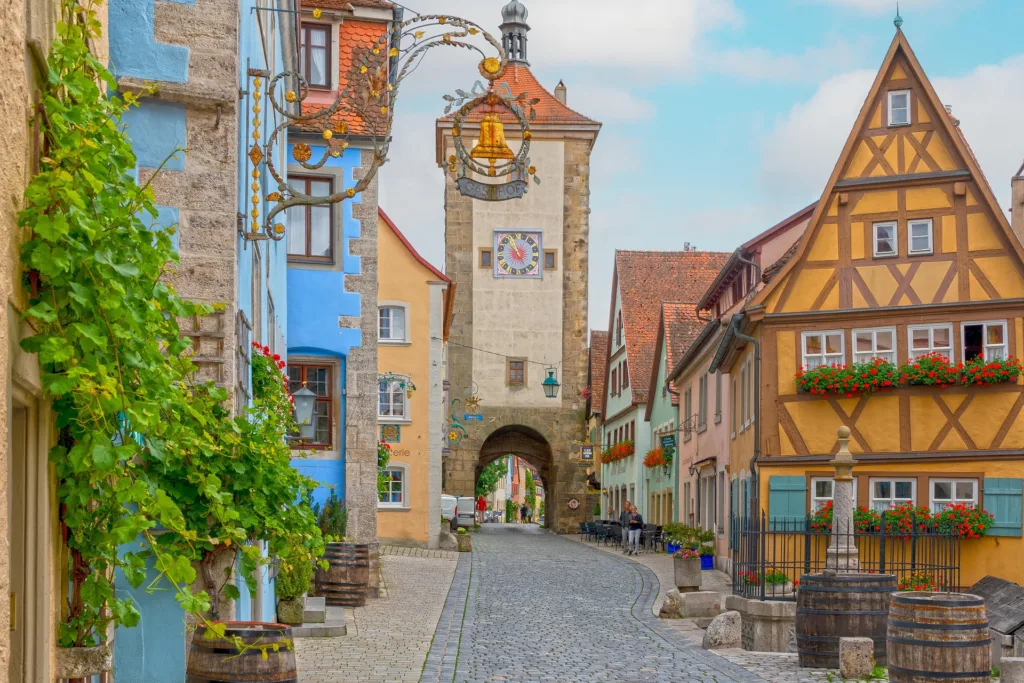
Step Into a Fairy Tale: The 10 Most Beautiful Towns in Germany
Germany is home to some of the most enchanting fairy-tale towns in the world. From cobblestone streets lined with half-timbered houses to castles soaring high above lush valleys, these magical destinations feel as though they’ve leapt straight out of the pages of a storybook. Wandering through these towns is not just a journey—it’s stepping into a living fairy tale where history, legends, and stunning landscapes combine to create unforgettable experiences.
Whether you’re experiencing the medieval charm of Rothenburg ob der Tauber, standing in awe of the iconic Neuschwanstein Castle, or discovering the hidden courtyards of Görlitz, every destination is a doorway to another time. For solo travelers, these towns offer the perfect mix of tranquility and adventure. You can freely explore scenic streets at your own pace, photograph charming alleyways, or pause at a quiet café to soak in the magic without distraction.
From riverside villages hugged by vineyards to festive market squares filled with life, these fairy-tale towns showcase Germany at its most picturesque. Ready to start your journey? Let’s dive into 10 of the most beautiful fairy-tale towns in Germany that are nothing short of magical.
Why Germany’s Fairy-Tale Towns Are a Dream for Solo Travelers
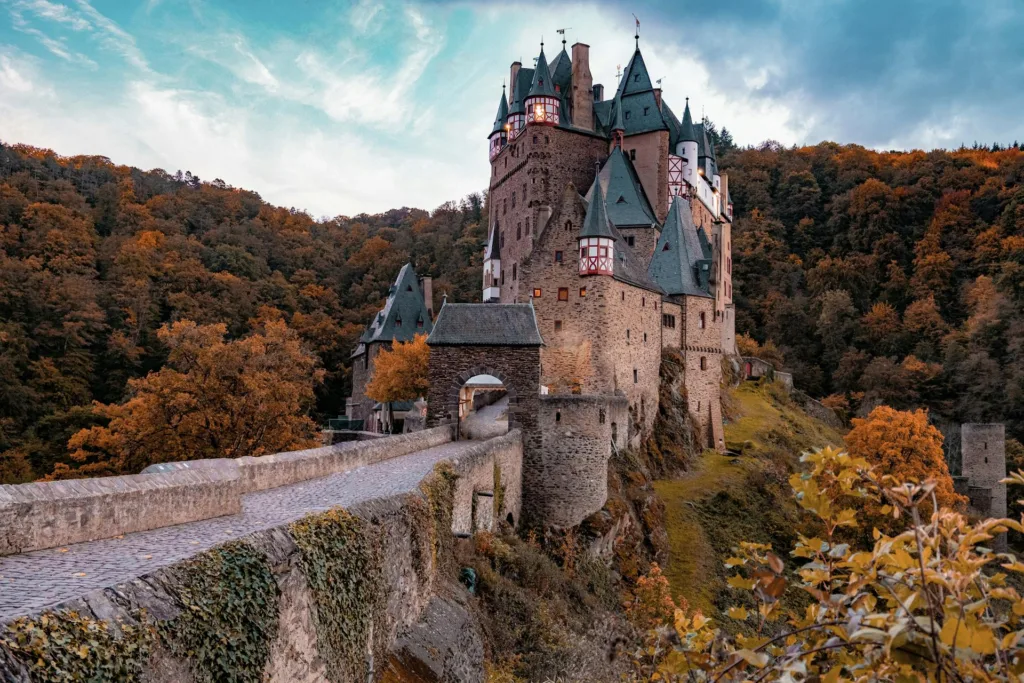
Photo by op23
Germany’s fairy-tale towns feel like they were designed for solo travelers. With winding cobblestone streets, vibrant medieval markets, and quiet corners perfect for reflection, these destinations allow you to explore entirely at your own pace. Each town is steeped in history and charm, inviting you to lose yourself in its storybook allure.
Here’s why these magical towns are ideal for solo travelers planning their next escape:
1. Easy Navigation and Walkability
- Compact Layouts: Most fairy-tale towns in Germany are small and incredibly walkable, with everything from cozy cafés to scenic parks within easy reach. You can leave complicated maps behind and simply follow the charming streets wherever they take you.
- Train-Friendly: For towns that are farther apart, Germany’s world-class public transportation system makes day trips or hopping between destinations seamless—even without a car.
- Peaceful Exploration: Traveling solo means you can explore quietly at your leisure, discovering hidden courtyards, ivy-covered walls, and breathtaking town squares without set schedules.
- Pro Tip: Stay overnight to enjoy the serenity of these towns after day-trippers leave. Early mornings and evenings are the best times to soak in their magic without the hustle.
2. Rich History and Storybook Charm
- Timeless Atmospheres: Step into streets that seem frozen in time, with half-timbered houses and medieval towers that echo centuries past. These towns even inspired some of the most famous Brothers Grimm fairy tales (like Rapunzel and Hansel and Gretel).
- Tangible Stories: Many of the towns come alive with local legends, historical reenactments, and museums displaying artifacts from their medieval past.
- Example: In Marburg, walk the same cobbled streets as the Brothers Grimm themselves, who gathered inspiration here for their fairy tales.
- Pro Tip: Visit during local festivals (like Rothenburg’s Christmas market or Quedlinburg’s medieval fairs) to experience the stories come to life.
3. Magical Scenic Beauty
- Tranquil Rivers and Vineyards: Imagine sitting by the Moselle River in Cochem or gazing at endless vineyards in Schwäbisch Hall. These breathtaking backdrops create the perfect setting for inner peace and creative inspiration.
- Breathtaking Castles and Views: Many fairy-tale towns are crowned by castles perched high above—offering spellbinding views of the landscape below. From Neuschwanstein Castle in Füssen to Wernigerode Castle in the Harz Mountains, these towns feel like works of art brought to life.
- Pro Tip: Bring a travel journal or sketchpad. The sights in these towns will make you want to capture the magic—whether through words, sketches, or photographs.
4. Perfect for Photography and Reflection
- Incredibly Photogenic: Solo travelers, especially those who love travel photography, will never run out of inspiration in these towns. The way sunlight hits cobblestones in early morning or glimmers on castle towers at golden hour provides endless opportunities for artistic shots.
- Example: Head to Marienbrücke in Füssen for the most iconic view of Neuschwanstein Castle.
- Embrace Solo Moments: These towns offer peaceful spaces for reflection. Sit by a riverbank, journal in a quiet park, or sip coffee in a 300-year-old square as the world moves gently around you. The best part? You get to savor these moments on your own terms.
- Pro Tip: For a photo-friendly adventure, bring a lightweight tripod for self-portraits against iconic backdrops like Rothenburg’s Plönlein corner or Quedlinburg’s Old Town rooftops.
5. Safety and Comfort for Solo Travelers
- Welcoming Atmosphere: Fairy-tale towns in Germany are known for their friendly locals who are used to hosting visitors from around the globe. English is widely spoken in tourist areas, so solo travelers will feel at ease navigating, ordering food, or getting directions.
- Peaceful Nights: These small towns are far removed from the fast pace of larger cities, making them perfect for quiet evening strolls after a day of exploring.
- Pro Tip: Stay in a traditional guesthouse or family-run inn for an even more welcoming experience (and perhaps a few local tips on hidden gems).
The 10 Most Beautiful Fairy-Tale Towns in Germany
Germany’s fairy-tale towns are more than just travel destinations—they’re places where history, beauty, and serenity combine to create unforgettable moments, even for first-time solo travelers. Whether you’re journaling by a castle, wandering through medieval streets, or capturing the glow of golden hour on your camera, these enchanting towns promise nothing short of magic.
Here’s the roundup of magical towns to visit—from Bavarian castles to pastel riverside villages.
1. Rothenburg ob der Tauber: Germany’s Ultimate Fairy-Tale Town
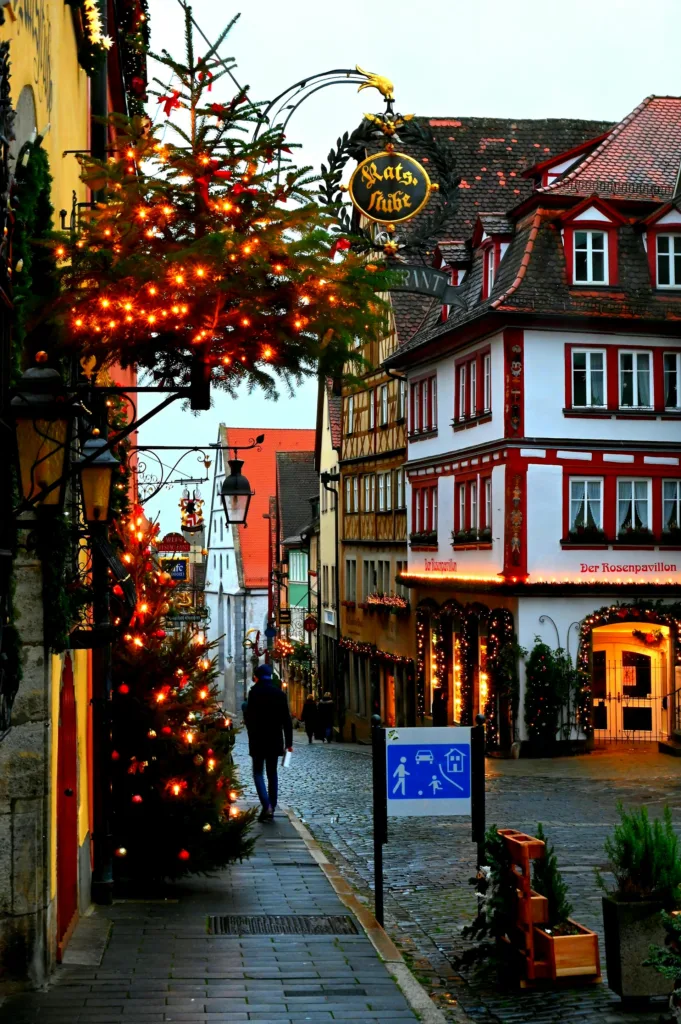
Photo by Charlie Bird
Why Visit Rothenburg ob der Tauber?
Rothenburg ob der Tauber is the quintessential fairy-tale town, and no list of beautiful towns in Germany is complete without it. Located in Bavaria along the Romantic Road, Rothenburg captures the magic of medieval Germany with its stunning half-timbered houses, red-roofed towers, and cobblestone streets that seem frozen in time.
This picture-perfect town is one of the best-preserved medieval villages in Europe, offering countless enchanting corners to explore. Whether you’re walking its ancient city walls or marveling at the charming Plönlein (Little Square), Rothenburg embodies the magic of stepping into a living storybook.
Highlights of Rothenburg ob der Tauber
1. The Iconic Plönlein (Little Square)
- Why Visit: The Plönlein is Rothenburg’s most photographed spot, and for good reason. With its sloping yellow timbered house, fountain, and diverging cobblestone paths, this location feels lifted straight from a fairy tale.
- Pro Tip: Visit the Plönlein in the early morning or evening when the soft light creates the perfect photo opportunity, and crowds are minimal.
2. Walk the Medieval Walls
- Why Visit: Rothenburg is surrounded by well-preserved medieval walls, much of which are walkable. The views from the top offer incredible perspectives of the town’s rooftops and countryside.
- Pro Tip: For a magical sunrise view, start your walk early in the morning while the village is still quiet. Look for plaques along the walls explaining their history.
3. Rothenburg Town Hall and Market Square (Marktplatz)
- Why Visit: The Town Hall (Rathaus) is a testament to Rothenburg’s rich heritage, with its mix of Gothic and Renaissance architecture. For panoramic views, climb to the top of the Town Hall Tower and take in the entire Old Town.
- Pro Tip: Time your visit with Rothenburg’s nightly Watchman’s Tour—an interactive and humorous look at the town’s medieval history.
4. The Medieval Crime and Justice Museum
- Why Visit: This one-of-a-kind museum offers a fascinating (and sometimes chilling) look into Europe’s medieval legal systems and punishments. From witch trials to medieval courtrooms, it’s a unique way to dive deeper into the town’s history.
- Pro Tip: Solo travelers will enjoy spending a quiet afternoon here—it’s quirky, informative, and off the beaten path.
5. The Burggarten (Castle Garden)
- Why Visit: Located on the site of an old castle, the Castle Gardenoffers peaceful walking paths, vibrant flowers, and a stunning lookout over the Tauber River Valley.
- Pro Tip: Bring a sketchpad or a journal to capture the views—you’ll feel like you’re in the secret garden of a fairy tale.
Solo Travel Tips for Rothenburg ob der Tauber
Best Time to Visit
- Spring (April-June): Lush greenery and fewer crowds make spring perfect for exploring Rothenburg’s gardens and quiet streets.
- Fall (September-November): The crisp autumn air and warm hues of the town’s foliage add even more charm.
- Winter (December): The world-famous Rothenburg Christmas Market makes winter magical, though it’s also the busiest time of year.
Pro Tip: For solo travelers, early mornings and weekday visits (outside holiday seasons) offer the quietest experience.
How to Get There
- By Train:
- Rothenburg is well-connected by train from major German cities. From Munich, it’s roughly 2.5 hours (with a transfer in Ansbach or Würzburg). From Nuremberg, it’s a quicker 1-hour journey with easy connections.
- By Car:
- Driving along the Romantic Road is a popular way to visit Rothenburg. Park in one of the designated areas outside the Old Town and explore on foot.
Where to Stay
- Hotel Gotisches Haus:
- Stay inside a piece of history—this Gothic-style hotel is centrally located near the Market Square.
- Perfect for Solo Travelers: Cozy rooms and friendly staff ensure a warm and relaxed stay.
- Gästehaus Edith:
- A charming, budget-friendly guesthouse with clean, comfortable rooms.
- Located just outside the Old Town’s walls, it’s quiet but still very walkable.
Dining Recommendations
- Zur Höll:
- One of Rothenburg’s oldest taverns, serving hearty Franconian dishes. The cozy, dimly lit atmosphere feels like stepping back in time.
- Perfect for Solo Travelers: Friendly service and small tables make it easy to dine alone.
- Rothenburg Bakeries:
- Don’t miss trying Schneeballen, Rothenburg’s signature pastry! Grab one from any local bakery (they come in flavors like chocolate, vanilla
Why Rothenburg is the Perfect Fairy-Tale Town
Rothenburg isn’t just one of the most beautiful towns in Germany—it’s also one of the most solo-friendly destinations. Its safe streets, welcoming locals, and peaceful vibes make it easy to slow down, breathe, and enjoy the magic at your own pace. Whether you’re wandering the charming alleys, sketching in the Castle Garden, or taking in golden-hour views from the city walls, Rothenburg proves that fairy tales aren’t just stories—they’re destinations waiting to be discovered.
2. Füssen: A Gateway to Neuschwanstein and Alpine Beauty
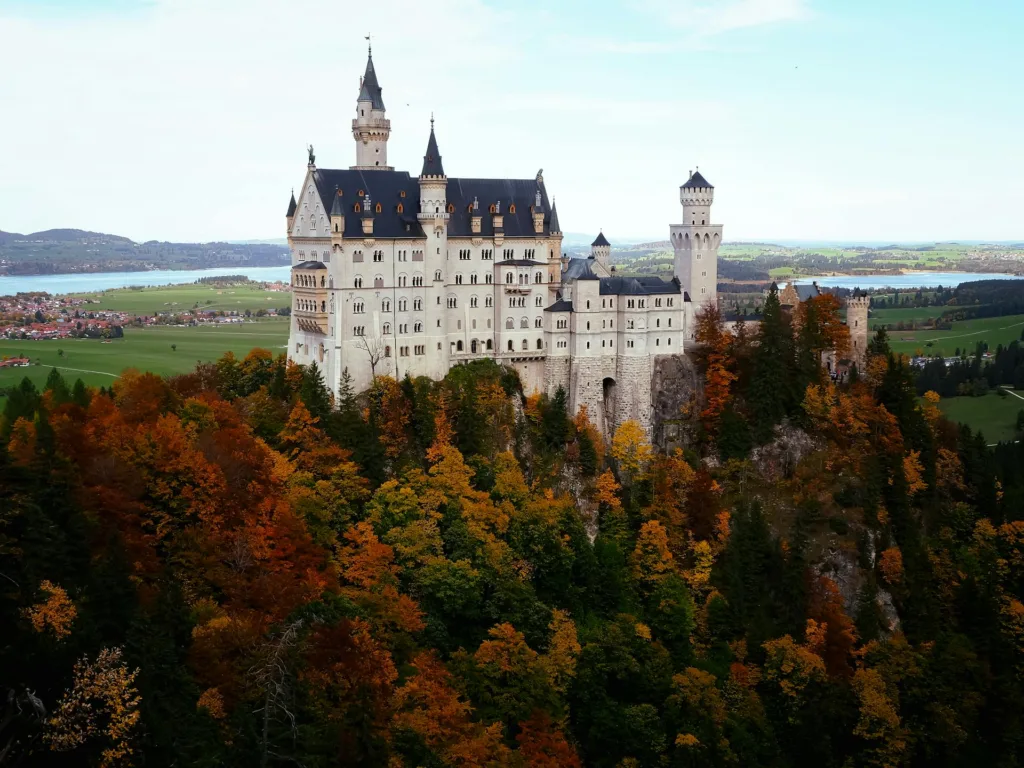
Photo by Tatiana
Why Visit Füssen?
Füssen is the ultimate fairy-tale destination, nestled at the foot of the Bavarian Alps. Famous for its proximity to Neuschwanstein Castle—the real-life inspiration for Disney’s Sleeping Beauty Castle—this charming town offers much more than just castles. Its colorful Old Town, serene Alpine lakes, and walking trails create a peaceful yet magical escape. Füssen is a perfect blend of awe-inspiring charm and tranquility, making it ideal for solo travelers who love reflective moments and breathtaking scenery.
Füssen isn’t just a jumping-off point for castle enthusiasts—it’s a destination that allows you to slow down, soak in nature, and enjoy history at your own pace.
Highlights of Füssen
1. Neuschwanstein Castle
- Why Visit: Rise above the clouds to discover one of the most famous castles in the world. Built by King Ludwig II, this whimsical creation is perched on rugged cliffs and surrounded by snow-capped peaks. Its dreamy white towers have inspired fairy-tale lovers and Disney fans alike.
- Fairy-Tale Moment:
“Standing on Marienbrücke Bridge, the mist swirling around Neuschwanstein Castle creates the perfect fairy-tale scene. As the sun breaks through, the golden glow transforms the castle into a vision of magic.” - Solo Travel Tips:
- Book in Advance: Reserve tickets online (up to 3 days before your visit) to save time and ensure availability.
- Best Viewpoint: Visit Marienbrücke (Mary’s Bridge) early in the morning for quiet, unobstructed views of the castle.
- Photography Tip: Overcast days can add a mystical feel to your photos, but golden hour light is spectacular. Bring a wide-angle lens for breathtaking landscape shots.
2. Alpsee Lake
- Why Visit: Nestled near Neuschwanstein, Alpsee Lake offers tranquil reflections of the surrounding mountains and forests. Staring into its crystal-clear water feels like stepping into a hidden fairy tale.
- Fairy-Tale Moment:
“The stillness of Alpsee Lake creates a mirror-perfect reflection of the snowy peaks and dense fir trees. It’s the kind of place where time stands still.” - Solo Travel Tips:
- Hike the trail around the lake for different perspectives, including photo-perfect angles of the castle in the distance.
3. Füssen’s Old Town
- Why Visit: Füssen’s Old Town feels like a colorful patchwork of medieval streets, bright facades, and charming squares. Its historical past shines through in every corner, with cobblestones leading to landmarks like the Hohes Schloss (High Castle) and St. Mang’s Abbey.
- Fairy-Tale Moment:
“Wander Füssen’s narrow alleys and stumble upon pastel-colored buildings with flower-filled windowsills. With every turn, you’ll feel like you’ve uncovered a story waiting to be told.” - Solo Travel Tips:
- Visit Reichenstrasse, the main street, for vibrant buildings, boutique shops, and cafés perfect for people-watching.
4. Hiking Trails and the Tegelberg Cable Car
- Why Visit: Füssen’s surroundings are an outdoor enthusiast’s dream. Whether you’re hiking along pristine forest paths or soaring over the Alps in the Tegelberg Cable Car, the scenery will leave you speechless. You’ll feel worlds away as you immerse yourself in nature’s splendor.
- Fairy-Tale Moment:
“Watching the Alpsee from above as you ascend Tegelberg Mountain feels like flying into the pages of a magical storybook.” - Solo Travel Tips:
- Opt for the Kalvarienberg Trail for a short, quiet hike with panoramic views of Füssen and the surrounding mountain peaks.
- Bring a light jacket—the mountain air is fresh and can be chilly, even in summer.
Solo Travel Tips for Füssen
How to Get There
- By Train: Füssen is a 2-hour journey from Munich’s Hauptbahnhof (main station), with trains departing frequently. Once you arrive, it’s a short bus ride (or 40-minute scenic walk) to Neuschwanstein Castle.
- By Car: If you’re driving, Füssen is easily accessible along Germany’s Romantic Road. Park in one of the castle lots and either hike or take the shuttle up.
Where to Stay
- Hotel Sonne Füssen:
- A bright, art-inspired boutique hotel in the heart of the Old Town.
- Perfect for Solo Travelers: Choose a mountain-view room for ultimate inspiration!
- Old Kings Hostel:
- A budget-friendly and cozy hostel decorated with fairy-tale themes, making it ideal for solo adventurers.
Dining Recommendations
- Madame Plüsch: A charming and whimsical restaurant that captures the fairy-tale vibe with vintage decor and classic Bavarian dishes.
- Altstadtcafé Füssen: Perfect for solo travelers wanting a quiet place to enjoy coffee and cake while admiring the cobblestone streets below.
Why Füssen Should Be on Your List
Füssen is much more than a gateway to Neuschwanstein Castle—it’s a destination in its own right. For solo travelers, it offers a perfect mix of natural beauty, magical castles, and peaceful moments by the lake. Whether you’re hiking, photographing, or soaking in the historic Old Town, Füssen invites you to slow down, breathe deeply, and let yourself feel the magic.
3. Görlitz: The Grand Budapest Hotel Town
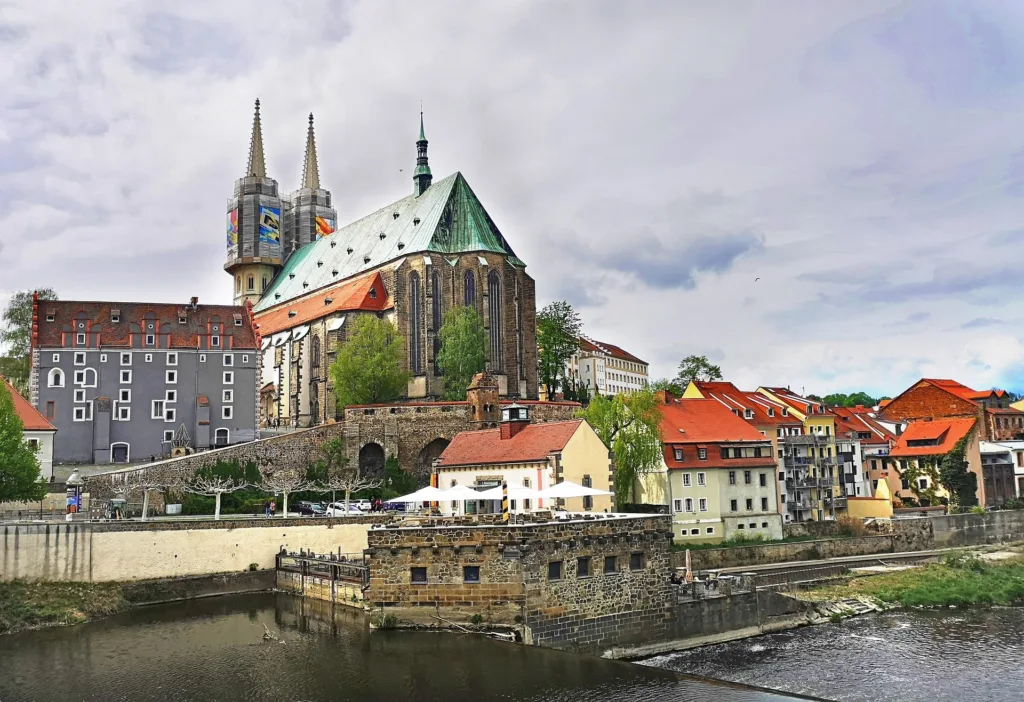
Image by Stephanie
Why Visit Görlitz?
Known as Germany’s most beautiful town by many who visit, Görlitz is a fairy-tale lover’s dream. With its pastel-colored buildings, cobblestone streets, and intricate Baroque architecture, Görlitz delivers unforgettable storybook vibes. Its pristine streets have been the backdrop for over 100 films, earning it the nickname “Görliwood” among filmmakers.
Despite its cinematic fame, Görlitz remains a hidden gem compared to bigger destinations in Germany, which makes it a tranquil retreat for solo travelers who love wandering through quiet medieval streets. You’ll feel like you’ve stepped onto the set of a movie—or the pages of a Grimm Brothers fairy tale.
Highlights of Görlitz
1. Obermarkt and Untermarkt (Main Squares)
- Why Visit: These two stunning squares form the heart of Görlitz and are lined with some of Germany’s most picturesque buildings. The Obermarkt features pastel-colored Renaissance and Baroque facades, while the Untermarkt feels like a timeless snapshot of medieval life.
- Fairy-Tale Moment:
“Standing in Untermarkt at twilight, with lanterns casting a golden glow over the colorful storefronts and cobblestones, feels like stepping into a magical world.” - Solo Travel Tips:
- Visit early morning or late evening for quiet reflection and empty streets perfect for photos.
- Grab a coffee from a local café on Obermarkt and people-watch as life unfolds around you.
2. Görlitzer Warenhaus (From The Grand Budapest Hotel)
- Why Visit: Movie buffs will recognize this stunning Art Nouveau department store from Wes Anderson’s The Grand Budapest Hotel. Its opulent interiors were transformed into the iconic hotel lobby, and even without the Hollywood magic, the building on its own is breathtaking.
- Fairy-Tale Moment:
“Walking through the grand halls of Görlitzer Warenhaus feels like entering another world—elegant, enchanting, and full of whimsy.” - Solo Travel Tips:
- Tours of Görlitzer Warenhaus are occasionally offered—check local schedules to plan your visit.
- Stand outside and imagine you’re a character in The Grand Budapest Hotel; the sheer scale of the setting is awe-inspiring.
3. St. Peter and Paul’s Church
- Why Visit: This Gothic masterpiece towers over Görlitz with its dramatic spires and intricate stonework. It’s one of the most striking churches in Germany and offers a peaceful atmosphere for solo travelers seeking moments of reflection.
- Fairy-Tale Moment:
“As you step inside, the soft light filtering through the stained glass and quiet echoes of whispers create an almost ethereal experience.” - Solo Travel Tips:
- Climb to the nearby Emperor Bridge (Kaisertrutz) for stunning views of the church and the Neiße River below.
4. The Old Town Bridge to Poland
- Why Visit: Görlitz is a town divided by the Neiße River, with one side in Germany and the other in Poland. Crossing the Old Town Bridgefeels like walking into another story, offering panoramic views of Görlitz’s colorful rooftops and the lush riverscape beyond.
- Fairy-Tale Moment:
“Crossing the Old Town Bridge as the sun sets, you’ll feel like you’re traversing the boundary between two magical lands.” - Solo Travel Tips:
- Bring your camera—the view from the bridge at sunset is spectacular.
- Take a short walk to Zgorzelec, the Polish side of Görlitz, to explore a quieter atmosphere with equally charming streets.
Solo Travel Tips for Görlitz
Best Time to Visit
- Görlitz is stunning year-round, but here’s how it changes with the seasons:
- Spring (March-May): Mild weather and blooming flowers make for peaceful strolls through the square.
- Summer (June-August): More vibrant and lively with festivals and outdoor dining in the squares.
- Fall (September-November): Golden foliage adds a magical touch to the already colorful scenery.
- Winter (December-February): Cozy Christmas markets bring a festive glow to the entire town.
How to Get There
- By Train: Görlitz is easily accessible by train from Dresden in less than 1.5 hours. It’s also connected through Berlin, though the journey takes about 3.5 hours.
- By Car: Driving to Görlitz allows you to enjoy the scenic countryside of Saxony en route.
Where to Stay
Romantik Hotel Tuchmacher
- Housed in a 16th-century building, this boutique hotel offers a blend of fairy-tale vibes and modern comfort, perfect for solo travelers.
Hotel Schwibbogen Görlitz
- A cozy, mid-range option located in the heart of the Old Town, ideal for those wanting to stay close to the main squares.
Dining Recommendations
- Caféhaus Lucullus: Charming and quaint, this café is perfect for solo travelers who want to enjoy coffee and cake while admiring the square.
- Zur Schwarzen Kunst: A historic pub with a medieval flair, serving hearty German classics in a cozy atmosphere.
Why Görlitz Should Be on Your Fairy-Tale Itinerary
Görlitz is not just a visual masterpiece—it’s a place where you’ll feel like you’ve stepped into a fairy tale. From exploring pastel streets to crossing into Poland or embracing cinematic nostalgia, Görlitz offers solo travelers a mix of history, charm, and quiet magic at every turn. Whether you’re tracing the paths of Hollywood legends or simply soaking in the peaceful atmosphere of its old squares, Görlitz is a town you’ll never forget.
4. Cochem: A Fairy-Tale Village in the Moselle Valley
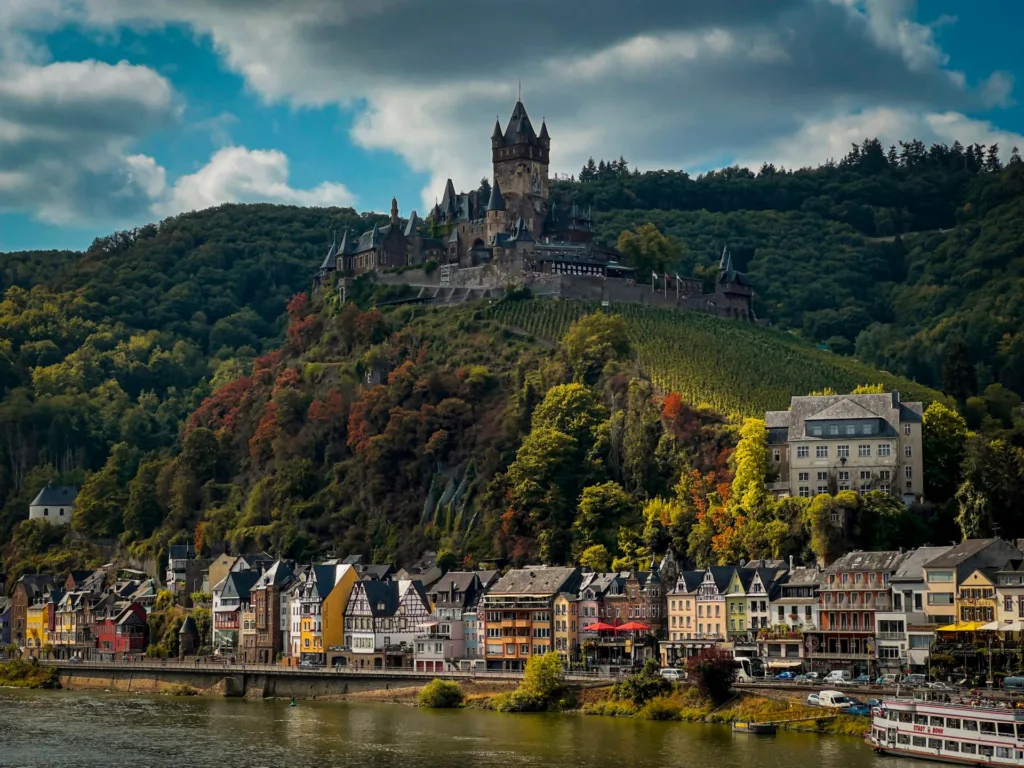
Photo by Vish Pix
Why Visit Cochem?
Nestled along the winding Moselle River, Cochem is like a postcard brought to life, complete with colorful riverside houses, rolling vineyards, and the majestic Reichsburg Castle dominating the skyline. As one of the most enchanting towns in Germany, Cochem combines fairy-tale charm with tranquil beauty, offering solo travelers a peaceful escape from the bustle of larger cities.
Whether you’re wandering along the riverbank, tasting world-famous Riesling wines, or climbing to the castle for panoramic views, Cochem feels like stepping into another world.
Highlights of Cochem
1. Reichsburg Castle
- Why Visit: Perched high above the town on a hill, Reichsburg Castleis Cochem’s crowning jewel. Its intricate Gothic Revival design and dramatic setting make it one of the most stunning castles in Germany.
- Fairy-Tale Moment:
“Climbing the winding trail to Reichsburg Castle feels like walking into a medieval romance. Standing on the castle terrace, you’ll be rewarded with breathtaking views of the Moselle Valley and vineyards stretching as far as the eye can see.” - Solo Travel Tips:
- Join a guided tour to learn about the castle’s medieval history and restoration.
- Visit close to sunset for golden hour views from the castle terrace—perfect for photography.
2. Moselle Riverboat Cruises
- Why Visit: Floating along the scenic Moselle River feels like traveling through a painting. Riverboat cruises are a relaxing way to enjoy the beauty of Cochem’s half-timbered houses, green vineyards, and dreamy riverscapes.
- Fairy-Tale Moment:
“As the boat glides past the serene riverbanks, the reflection of Reichsburg Castle in the water below creates an enchanting scene that feels straight out of a storybook.” - Solo Travel Tips:
- Choose an early morning cruise for a quieter and more serene experience.
- Longer cruises often stop at nearby villages like Beilstein, which is equally picturesque.
3. Old Town (Altstadt)
- Why Visit: Cochem’s Old Town is a maze of narrow cobblestone streets, lined with charming half-timbered houses and quirky shops. Its historic Marktplatz (market square) is the heart of the town, where locals and visitors gather to enjoy vibrant stalls, fountains, and relaxing cafés.
- Fairy-Tale Moment:
“Wandering aimlessly through the Old Town feels like uncovering the secrets of a forgotten fairy tale, with every alley and corner revealing hidden gems.” - Solo Travel Tips:
- Visit lesser-known side streets to capture quiet moments and unique photo opportunities.
- Stop at a cozy café—many have outdoor seating with views of the market square.
4. Local Wineries and Riesling Tastings
- Why Visit: Surrounded by some of the best vineyards in the Moselle Valley, Cochem is renowned for its crisp and refreshing Riesling. Joining a wine tasting is the perfect way to unwind and connect with locals who have mastered the art of winemaking.
- Fairy-Tale Moment:
“Sipping a glass of Riesling while overlooking rolling vineyards and the Moselle River creates the perfect mix of indulgence and tranquility.” - Solo Travel Tips:
- Most wineries offer small-group tastings, so solo travelers can mingle while enjoying a personal and cozy atmosphere.
- Try the family-run Weingut Walter J. Oster for a truly authentic experience.
5. Pinnerkreuz Viewpoint
- Why Visit: For the best panoramic views of Cochem, hike or take the cable car to Pinnerkreuz, a high vantage point overlooking the town, castle, and river below. It’s a hiker’s dream or a scenic haven for quiet reflection.
- Fairy-Tale Moment:
“Standing at the Pinnerkreuz Viewpoint, you can see all of Cochem’s magic come together—a colorful riverside town hugged by vineyards and shadowed by its majestic castle.” - Solo Travel Tips:
- The cable car is faster, but the short hike to Pinnerkreuz offers quiet, scenic trails perfect for solo adventurers.
Solo Travel Tips for Cochem
Best Time to Visit
- Spring (April-May): For colorful blooming flowers along the Moselle River and peaceful walks through the vineyards.
- Fall (September-October): Perfect for wine lovers, as fall brings the Moselle wine festival and golden hues to the valley.
- Pro Tip: Visit in early spring or late fall to avoid summer crowds while still enjoying pleasant weather.
How to Get There
- By Train: Cochem is accessible via Germany’s rail network, with trains connecting it to Koblenz (under 40 minutes) and Trier (about 1 hour).
- By Car: Driving along the Moselle Wine Route is a scenic experience in itself, with numerous stops at vineyards and villages en route.
Where to Stay
- Hotel Zehnthof Cochem:
- A family-run hotel with cozy, uniquely decorated rooms offering stunning views of the Moselle River and Reichsburg Castle.
- Altes Winzerhaus:
- Nestled near the riverbank, this guesthouse pairs quaint charm with warm hospitality, ideal for solo travelers.
Dining Recommendations
- Akropolis Cochem: Authentic Greek cuisine with a modern twist, perfect for a relaxing solo dinner with a glass of local wine.
- Alte Thorschenke: A fairy-tale-style restaurant inside a 700-year-old timbered house serving hearty German meals like schnitzel and bratwurst.
Why Cochem Should Be on Your Fairy-Tale Itinerary
Cochem is the perfect blend of history, nature, and indulgence. Its magical setting in the Moselle Valley, combined with its fairy-tale castle and serene atmosphere, makes it a paradise for solo travelers seeking tranquility and charm. Whether you’re cruising the Moselle, savoring wine with riverside views, or gazing down at the town from Reichsburg Castle, Cochem promises a fairy tale that you’ll carry with you long after you leave.
5. Quedlinburg: A Medieval Dream in the Harz Mountains
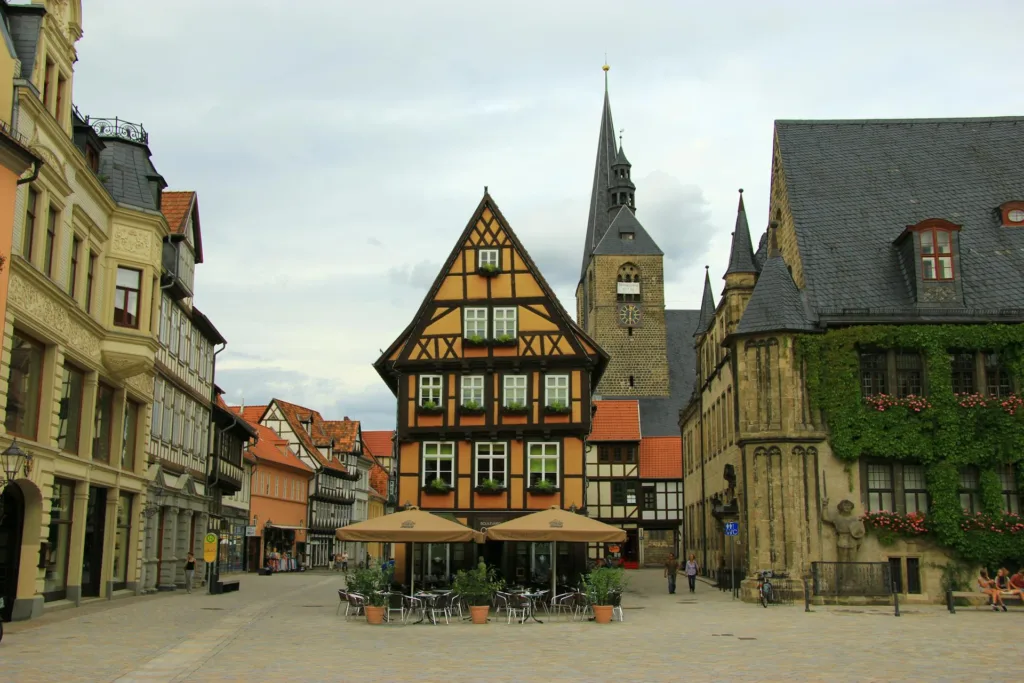
Photo by Izzet Arli
Why Visit Quedlinburg?
Quedlinburg is a true step back in time. Nestled in the foothills of the Harz Mountains, this UNESCO World Heritage Site enchants visitors with over 1,200 half-timbered houses—some dating back to the 14th century. Its cobblestone streets, colorful rooftops, and medieval charm make it one of the most magical towns in Germany. For those with a love for history and fairy-tale settings, Quedlinburg is a must-visit.
Beyond its fairy-tale beauty, Quedlinburg offers solo travelers a quiet escape. Its compact size makes it perfect for exploring at your own pace, and its peaceful streets are ideal for photography, journaling, or simply pausing to take in its historic ambiance.
Highlights of Quedlinburg
1. Quedlinburg Castle and St. Servatius Church (Schlossberg)
- Why Visit: Perched atop Castle Hill (Schlossberg), the castle and church are symbols of Quedlinburg’s rich history. This was once the seat of German kings during the Saxon dynasty, and the Collegiate Church of St. Servatius holds one of the most important medieval art collections in Europe.
- Fairy-Tale Moment:
“Standing on Castle Hill, gazing out over Quedlinburg’s red rooftops and winding streets, it’s easy to imagine yourself in the pages of a medieval romance.” - Solo Travel Tips:
- Visit the church in the morning for a serene atmosphere perfect for wandering.
- Don’t miss the panoramic views from the top of Castle Hill as the sun sets over the town.
2. Marktplatz (Market Square)
- Why Visit: The heart of Quedlinburg, its vibrant Marktplatz is surrounded by half-timbered houses and dominated by the ivy-covered Town Hall. With a fountain at its center, this square feels like it’s been frozen in time.
- Fairy-Tale Moment:
“As daylight fades and lanterns begin to glow, the peaceful hum of Marktplatz transforms it into a scene straight out of Rapunzel’s kingdom.” - Solo Travel Tips:
- Visit early in the morning to enjoy the square when it’s quiet and peaceful.
- Stop by a local bakery for coffee and pastries while watching the town come to life.
3. Fachwerkhäuser (Half-Timbered Houses)
- Why Visit: Quedlinburg boasts Europe’s largest collection of half-timbered houses, each telling its own story through unique architectural details. Wandering through these streets is like flipping through the pages of a storybook, with colorful facades and artistic ornaments adorning nearly every house.
- Fairy-Tale Moment:
“Lose yourself in a maze of cobblestone alleys, where every turn reveals enchanting timbered houses and hidden courtyards filled with flowers.” - Solo Travel Tips:
- Explore Hölle Street, one of Quedlinburg’s oldest and most picturesque alleys.
4. Münzenberg Hill
- Why Visit: Quedlinburg’s charm extends beyond Castle Hill to the lesser-known Münzenberg, a quaint neighborhood perched on a hill opposite the Old Town. You’ll find quieter cobblestone streets and stunning views of the historic rooftops below.
- Fairy-Tale Moment:
“Standing on Münzenberg Hill, with Quedlinburg’s castle and spires before you, feels like you’ve stumbled into an untouched fairy tale.” - Solo Travel Tips:
- Wander off the beaten path to Münzenberg
5. Brühl Park
- Why Visit: This serene park, located just outside the Old Town, is the perfect escape for solo travelers needing a break from sightseeing. Shaded pathways, open meadows, and benches overlooking the town make it an oasis of calm.
- Fairy-Tale Moment:
“Sitting under a tree in Brühl Park, with the distant hum of medieval streets, feels like living inside a story that’s unfolding at your pace.” - Solo Travel Tips:
- Bring a picnic or a sketchbook for quiet moments of solitude in the park.
Solo Travel Tips for Quedlinburg
Best Time to Visit
- Spring (April-May): Quedlinburg comes alive with blooming flowers and colorful markets—a dreamy time for photographers.
- Winter (December): Visit during Quedlinburg’s famous Christmas Market, where the half-timbered buildings glow under twinkling lights, and the whole town feels like a festive fairy tale.
How to Get There
- By Train: Direct trains connect Quedlinburg to major hubs like Magdeburg (1 hour) and Berlin (about 3.5 hours). Traveling by rail offers scenic views of the Harz countryside.
- By Car: Driving is ideal if you plan to explore nearby Harz villages. There’s ample parking outside the Old Town walls.
Where to Stay
- Hotel Theophano:
- A cozy boutique hotel located in the heart of Marktplatz. Its half-timbered style adds an authentic Quedlinburg touch.
- Samocca Quedlinburg:
- A budget-friendly option with charming rooms near the Old Town, perfect for solo travelers seeking peace.
Dining Recommendations
- Weinstube im Hotel Theophano: Enjoy traditional German food in a fairy-tale setting while surrounded by rustic beams and wooden furniture.
- Café Vincent: A tranquil spot for coffee and cake, nestled within a quiet courtyard.
Why Quedlinburg Should Be on Your Travel List
Quedlinburg isn’t just a town—it’s a living fairy tale that invites you to slow down and immerse yourself in its history and beauty. From its medieval streets and vibrant squares to its stunning views from Castle Hill, this gem of the Harz Mountains is perfect for solo travelers seeking inspiration and peace. Whether you’re walking the cobblestones, marveling at timbered houses, or taking in lush park views, Quedlinburg offers pure magic in every moment.
6. Monschau: A Serenely Hidden Fairy-Tale Gem
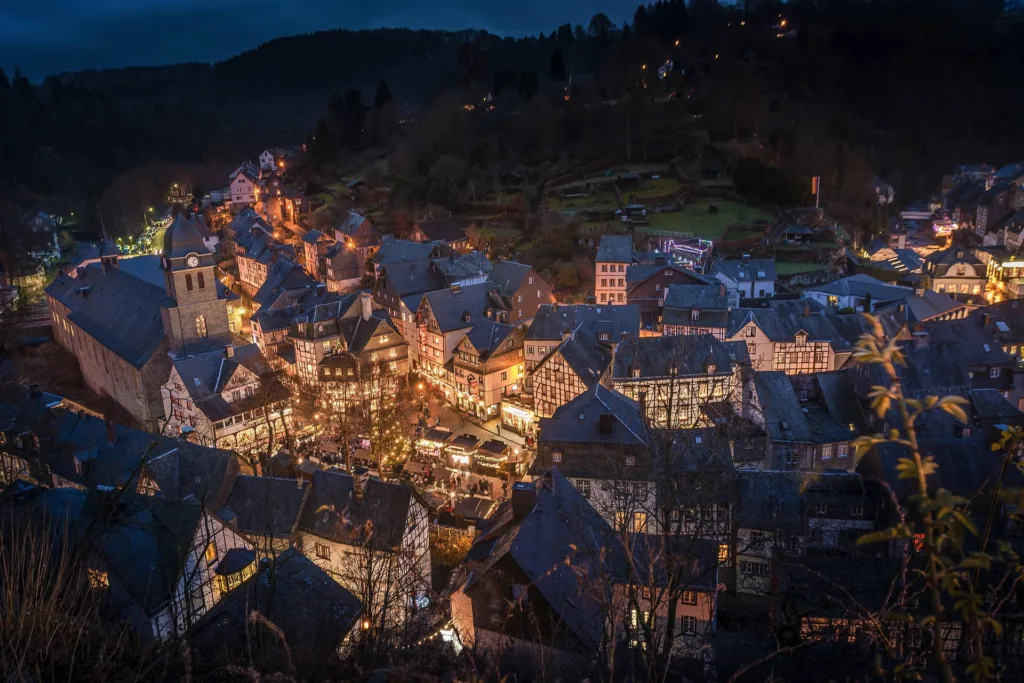
Why Visit Monschau?
Nestled in a lush green valley along the Rur River, Monschau is one of Germany’s most picturesque towns, known for its timber-framed houses, flower-filled windowsills, and tranquil atmosphere. Largely untouched for over 300 years, this charming town feels like a quiet, tucked-away corner of a fairy tale. Strolling its cobbled streets and crossing its old stone bridges offers moments of peaceful serenity, making it perfect for solo travelers seeking a slower pace.
Beyond its fairy-tale streets, Monschau opens the door to the beautiful Eifel National Park, offering forested trails, breathtaking views, and outdoor adventures.
Highlights of Monschau
1. Rotes Haus (The Red House)
- Why Visit: This iconic 18th-century Rococo mansion, known as the Red House, stands out with its bold red facade and elegant design. Inside, you’ll discover exhibits showcasing the luxurious lifestyle of a wealthy cloth merchant’s family.
- Fairy-Tale Moment:
“The grand staircase inside the Red House, with its intricate carvings and sweeping curves, feels like something out of a Cinderella ball.” - Solo Travel Tips:
- Climb to the attic to view the historic textile machines and see how Monschau became a center for textile trade.
2. Monschau Castle and the Haller Ruins
- Why Visit: Overlooking the town, the Monschau Castle ruinstransport you back to medieval Germany. Though the castle itself is now used as a youth hostel, the grounds offer sweeping views of the valley and the storybook town below.
- Fairy-Tale Moment:
“Standing atop the ruins, with Monschau’s rooftops glowing in the valley below, feels like peering into the world of Snow White.” - Solo Travel Tips:
- Hike up the short trail to the castle for spectacular sunrise or sunset photos of the town.
3. The Rur River and Monschau’s Stone Bridges
- Why Visit: The Rur River winds through the heart of Monschau, lined by timber-framed houses on one side and picturesque cafés on the other. The town’s stone bridges add a romantic and photographic element to every walk.
- Fairy-Tale Moment:
“Crossing the small arched bridges as the river quietly flows beneath feels like stepping into a dream of timeless charm.” - Solo Travel Tips:
- Pause by the Burgau Bridge for some of the best views of the river and houses.
4. Eifel National Park
- Why Visit: This sprawling national park is perfect for travelers seeking tranquility or adventure. From gentle walks to more vigorous hikes, the park’s trails lead you through dense forests, clear lakes, and rolling hills.
- Fairy-Tale Moment:
“Walking under towering trees with shards of sunlight breaking through feels like wandering a woodland from a Grimm Brothers tale.” - Solo Travel Tips:
- Hike the Wilderness Trail, a peaceful 18 km route—with smaller trail sections for easier exploration.
- Visit Felsenley Viewpoint for stunning panoramas of the Eifel landscape.
5. Monschau’s Christmas Market
- Why Visit: During winter, Monschau transforms into a magical snow globe, with twinkling Christmas lights, stalls selling handmade crafts, and the smell of mulled wine filling the air. Its small size makes it one of Germany’s most intimate and charming Christmas markets.
- Fairy-Tale Moment:
“Sipping mulled wine by the river as snowflakes settle softly feels like something only a storybook could create.” - Solo Travel Tips:
- Visit weekday mornings in December for a quieter holiday experience.
Solo Travel Tips for Monschau
Best Time to Visit
- Spring (April-May): Lush greenery and blooming floral displays on the timbered houses make the town feel fresh and alive.
- Autumn (September-October): Monschau’s valley glows with golden leaves, perfect for hikers and photographers.
- Winter (December): The Christmas market transforms the town into a winter wonderland, with fairy lights reflecting off the Rur River.
How to Get There
- By Train and Bus: Monschau is not directly connected by train but can be reached via Aachen Station. From Aachen, shuttle buses (under 1 hour) take you through the scenic Eifel region right to Monschau.
- By Car: Driving through the Eifel’s winding roads is the best option to explore Monschau and nearby natural attractions.
Where to Stay
- Hotel Horchem:
- A traditional hotel nestled along the Rur River, offering a fairy-tale view just steps from Monschau’s bridges.
- Gästehaus Flosdorff:
- A cozy, budget-friendly guesthouse perfect for solo travelers looking for charm and affordability.
Dining Recommendations
- Café Kaulard: A quaint café serving delicious coffee, local pastries, and sweeping riverside views.
- Restaurant Rur-Café: Enjoy hearty German meals like schnitzel while watching the gentle flow of the river from this historic café.
Why Monschau Should Be on Your Fairy-Tale Itinerary
Monschau isn’t just a town—it’s an experience of pure tranquility and timeless beauty. Its peaceful streets, romantic river views, and enchanting valley setting make it the perfect destination for solo travelers seeking solace and inspiration. Whether you’re journaling by the riverbanks, exploring medieval castle ruins, or sipping mulled wine under Christmas lights, Monschau invites you to slow down, take in the moment, and embrace its storybook magic.
7. Marburg: A Fairy-Tale Town with Grimm Connections
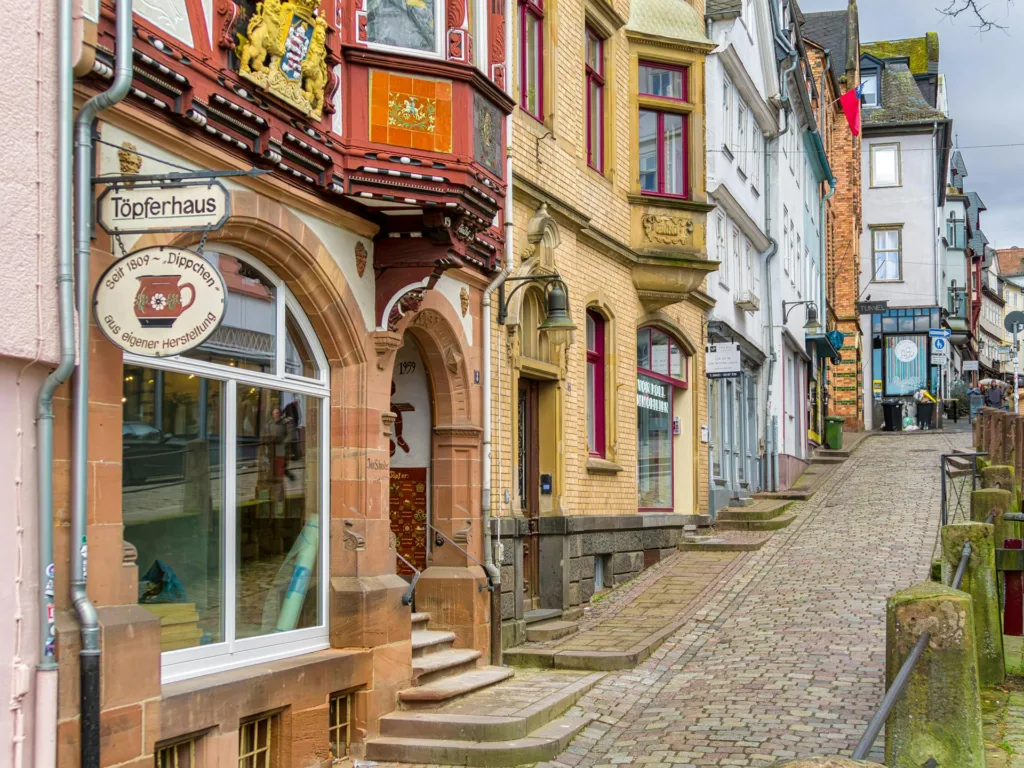
Photo by Mariusz Zając
Why Visit Marburg?
Marburg is nothing short of a living fairy tale, with its labyrinth of cobblestone streets, steep alleys, and picturesque half-timbered houses climbing up toward a grand castle. Nestled along the Lahn River, this medieval university town served as a major source of inspiration for the Brothers Grimm, who studied law at the University of Marburg in the early 1800s. It’s easy to see how the town’s charming Old Town and peaceful surroundings sparked the legends of Hansel and Gretel and Rapunzel.
For solo travelers, Marburg offers the perfect blend of history, enchantment, and self-paced exploration. Whether you’re tracing the footsteps of the Brothers Grimm along the Grimm Path or losing yourself in the quiet beauty of the Old Town, Marburg promises moments of wonder and reflection.
Highlights of Marburg
1. The Old Town (Altstadt)
- Why Visit: Marburg’s Old Town is a maze of steep, cobblestone streets lined with half-timbered houses, cozy cafes, and vibrant shopfronts. Each turn reveals hidden courtyards, ornate doorways, or whimsical street art.
- Fairy-Tale Moment:
“Getting lost in the Altstadt feels like entering a storybook, with colorful facades and sloping lanes that lead to unseen adventures.” - Solo Travel Tips:
- Wander early in the morning before the streets fill with activity—it’s the perfect time for photography.
- Bring comfortable shoes for the steep and sometimes uneven paths.
2. The Grimm Path (Grimm-Dich-Pfad)
- Why Visit: This themed walking trail traces Marburg’s connection to the Brothers Grimm. Along the way, you’ll encounter whimsical sculptures and plaques referencing fairy tales like Cinderella, Hansel and Gretel, and The Frog Prince.
- Fairy-Tale Moment:
“Standing before the Frog Prince statue or spotting a ‘glass slipper’ along the Grimm Path feels like stepping into the Brothers Grimm’s fantastical imagination.” - Solo Travel Tips:
- Download the Grimm Path map in advance to make sure you don’t miss any hidden surprises.
3. Landgrave Palace (Landgrafenschloss)
- Why Visit: Perched high above the town, Marburg’s castle offers panoramic views of the Old Town and surrounding countryside. The castle itself is a mix of medieval and Renaissance architecture, with a museum showcasing the town’s history.
- Fairy-Tale Moment:
“The climb to Landgrave Palace, with its towering spires and sweeping views, feels like ascending to a fairytale fortress.” - Solo Travel Tips:
- Visit the museum inside the castle for a quiet and reflective afternoon. The view from the castle courtyard during sunset is magical.
4. Elisabeth Church (Elisabethkirche)
- Why Visit: This Gothic masterpiece, dedicated to Saint Elizabeth of Hungary, is one of Germany’s oldest and most impressive Gothic churches. Its dramatic spires and intricate stonework make it a must-see landmark in Marburg.
- Fairy-Tale Moment:
“Walking through the towering arches and soft light of Elisabeth Church feels like stepping into something grand and eternal.” - Solo Travel Tips:
- Spend a few quiet moments reflecting inside the church—it’s a peaceful break from sightseeing.
5. The Lahn Riverfront
- Why Visit: For moments of tranquility, head to the Lahn River, where scenic walking paths invite solo travelers to relax or take a peaceful stroll.
- Fairy-Tale Moment:
“The sound of the flowing river, framed by lush greenery and the silhouette of Marburg Castle, creates a serene fairytale-like atmosphere.” - Solo Travel Tips:
- Pack a light picnic and sit by the riverside—an ideal spot for journaling or sketching.
Solo Travel Tips for Marburg
Best Time to Visit
- Spring (April-May): Enjoy pleasant weather and blooming flowers along the Lahn River and the Grimm Path.
- Autumn (September-October): The town is draped in warm hues, creating a magical atmosphere for fairy-tale exploration.
- Winter (December): Visit for Marburg’s Christmas markets, where the Old Town comes alive with twinkling lights, mulled wine, and festive cheer.
How to Get There
- By Train: Marburg is well-connected to major cities like Frankfurt (about 1 hour) and Kassel (approximately 50 minutes) via frequent regional trains.
- By Car: Driving provides flexibility, especially if you want to explore nearby towns on the Fairy Tale Route. Parking is available near the Old Town.
Where to Stay
- Hotel Vila Vita Rosenpark: A tranquil riverside retreat offering modern comforts and spa facilities, perfect for solo travelers seeking relaxation.
- Elisabeth Bräu Hotel: Located near Elisabeth Church, this charming hotel balances its historic vibe with cozy accommodations.
Dining Recommendations
- Cafe Barfuß: A stylish café offering local specialties and desserts in a relaxed, bohemian ambiance.
- Zur Sonne: A traditional German eatery tucked in the Old Town, serving hearty meals perfect for recharging after a day of exploring.
Why Marburg Should Be on Your Travel List
With its magical connection to the Brothers Grimm, atmospheric Old Town, and medieval landmarks, Marburg casts a spell on every visitor. For solo travelers, it offers quiet corners for reflection, stunning architecture, and the chance to explore at your own pace. Whether you’re tracing fairy-tale inspirations on the Grimm Path, climbing to Landgrave Palace, or strolling the serene Lahn River, Marburg effortlessly blends history with enchantment. It’s a fairy-tale escape waiting to be discovered.
8. Wernigerode: The Colorful Town in the Harz Mountains
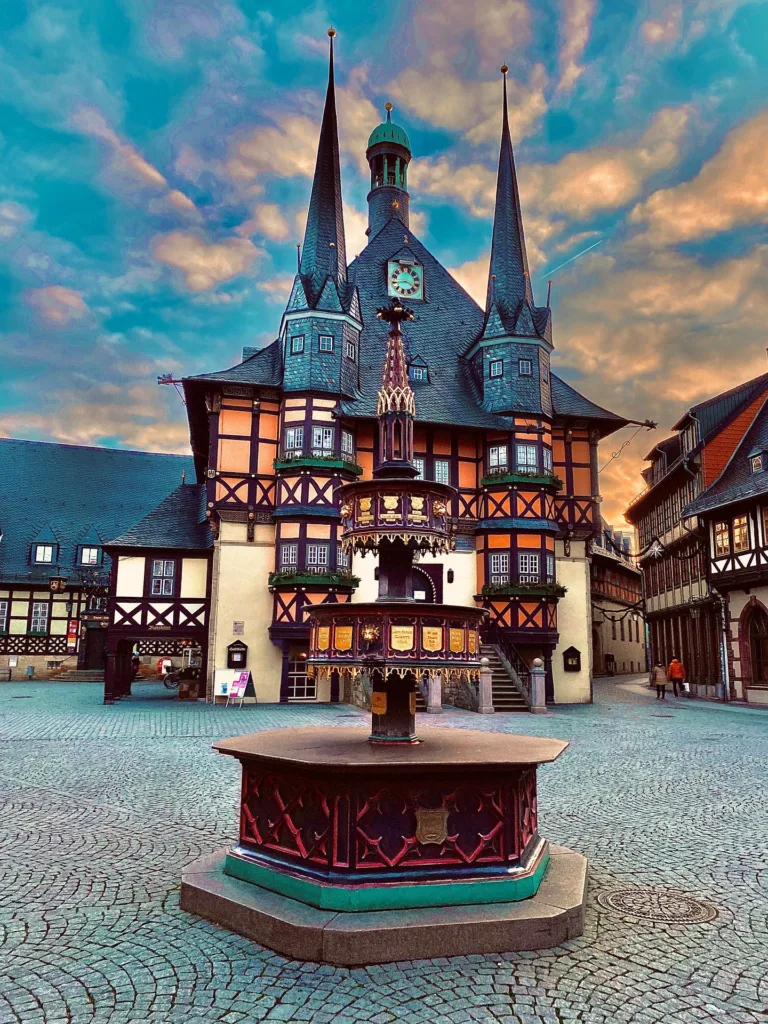
Image by Andreas Köchy®
Why Visit Wernigerode?
Wernigerode, fondly known as the “Colorful Town in the Harz,” is an enchanting destination for anyone seeking fairy-tale charm. With its vibrant half-timbered houses, cobblestone streets, and iconic castle perched above the town, Wernigerode feels like a storybook come to life. Nestled at the edge of the Harz Mountains, it’s a perfect blend of natural beauty and medieval history.
Whether you’re strolling through its picturesque Old Town, marveling at Wernigerode Castle, or boarding a historic steam train to the Brocken summit, every corner of Wernigerode exudes magic. Solo travelers, in particular, will love its relaxed atmosphere, walkable streets, and stunning views that inspire peaceful moments and quiet reflection.
Highlights of Wernigerode
1. Wernigerode Castle (Schloss Wernigerode)
- Why Visit: Sitting majestically on a hill overlooking the town, Wernigerode Castle offers breathtaking views and a glimpse into German history. This 12th-century castle, with its striking neo-Gothic design, is a feast for the eyes both inside and out. Stroll through its lavishly furnished rooms to imagine life as it was centuries ago.
- Fairy-Tale Moment:
“Walking up the winding paths to Wernigerode Castle feels like reaching the castle of your dreams, complete with panoramic views of red rooftops and the forested Harz Mountains.” - Solo Travel Tips:
- Take your time walking up to the castle; the scenic route is perfect for a quiet stroll.
- Visit in the late afternoon for fewer crowds and magical sunset views from the castle courtyard.
2. The Old Town (Altstadt)
- Why Visit: Wernigerode’s Old Town is a kaleidoscope of colorful half-timbered houses lining cobbled streets. At the heart of it all is the stunning Wernigerode Town Hall, an architectural masterpiece with its ornate turrets and timber-framed facade.
- Fairy-Tale Moment:
“Standing in the Old Town’s central square, with the vibrant Town Hall behind you and flickering lanterns lighting the streets, feels like stepping into a Brothers Grimm tale.” - Solo Travel Tips:
- Wander early in the morning or during golden hour for perfect photo opportunities.
- Explore hidden alleys to discover quieter corners and quaint shops.
3. Harz Narrow Gauge Railway
- Why Visit: Step into the past with a ride aboard the Harz Narrow Gauge Railway, a historic steam train that winds through dense forests and charming villages. The train’s most famous route takes travelers to the Brocken, the highest peak in the Harz Mountains, offering incredible views.
- Fairy-Tale Moment:
“The rhythmic chugging of the steam engine and the whistle echoing through the hills transport you to a forgotten world of adventure.” - Solo Travel Tips:
- Book tickets in advance during peak seasons (autumn and summer).
- Take the train one way and hike back for a balanced mix of experiences.
4. The Smallest House
- Why Visit: This quirky attraction on Kochstrasse is a narrow, 2-meter-wide house from the 18th century. It’s both adorable and fascinating—a small slice of Wernigerode’s history.
- Fairy-Tale Moment:
“Peeking into the Smallest House and imagining life within its snug walls feels like visiting a home straight out of a fairy-tale woodland village.” - Solo Travel Tips:
- Stop by while exploring the Old Town for a quick and whimsical experience.
5. Harz Mountains Hikes
- Why Visit: Beyond the town, Wernigerode opens up to the natural beauty of the Harz Mountains. With trails winding through lush forests, serene valleys, and rocky peaks, this region is perfect for solo adventurers craving peace and quiet.
- Fairy-Tale Moment:
“Following a forest trail with sunlight streaming through the trees feels like setting off on your own fairy-tale quest.” - Solo Travel Tips:
- Choose trails suited to your fitness level. A leisurely stroll through the Harz National Park or a more challenging hike to the Brocken are great options.
- Pack water, snacks, and a travel journal—it’s an inspiring spot for reflection.
Solo Travel Tips for Wernigerode
Best Time to Visit
- Spring (April-May): The blooming flowers in the Old Town make the colors even more vibrant.
- Autumn (September-November): The Harz Mountains come alive with golden foliage, making the town and surrounding nature particularly photogenic.
- Winter (December): Wernigerode glows with festive lights and Christmas markets, creating a wonderland feel.
How to Get There
- By Train: Trains connect Wernigerode to Berlin (3 hours) and Hanover (2 hours). Regional trains make the Old Town easily accessible.
- By Car: Driving allows flexibility to explore the Harz Mountains. Parking lots are available near the Old Town.
Where to Stay
- Travel Charme Gothisches Haus: A beautifully restored hotel in the Old Town with half-timbered charm and modern amenities. Ideal for solo travelers seeking comfort and convenience.
- Harz Hostel: A budget-friendly option offering clean and cozy rooms, perfect for independent travelers.
Dining Recommendations
- Zeitwerk Restaurant: A modern take on German cuisine, offering creative dishes made with local ingredients.
- Café Wien: Stop here for coffee, cake, and a cozy ambiance in a delightful Old Town setting.
Why Wernigerode Should Be on Your Travel List
Wernigerode is a magical destination that blends natural beauty with colorful charm. Its vibrant streets, historic landmarks, and proximity to the Harz Mountains make it a dream for solo travelers. Whether you’re admiring the view from Wernigerode Castle, journeying on a steam train, or wandering through the enchanting Old Town, this vibrant fairy-tale town will capture your heart.
9. Bamberg: Little Venice of Germany
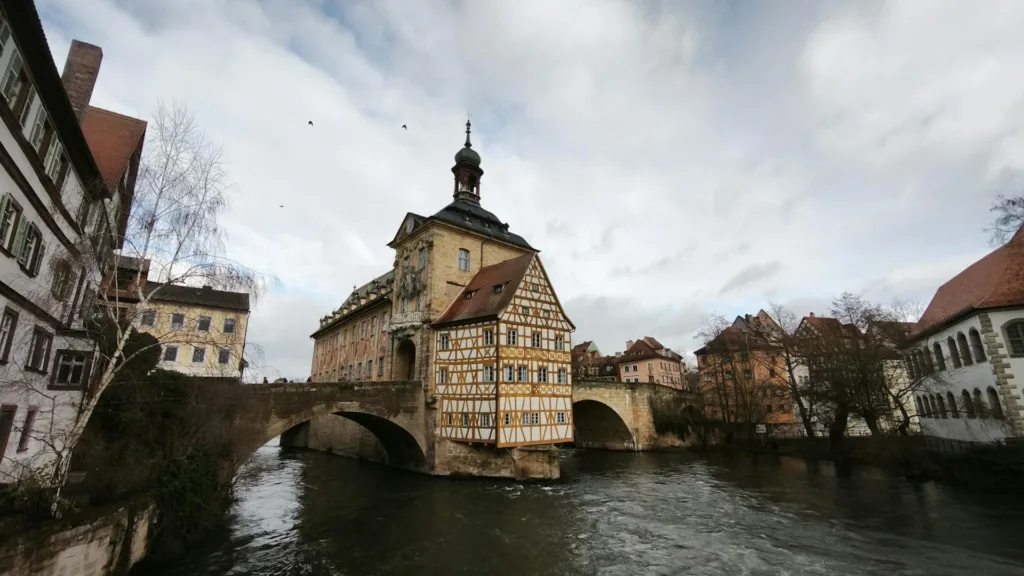
Photo by Alyona Nagel
Why Visit Bamberg?
Nestled in the heart of Bavaria, Bamberg is a city like no other—a magical blend of medieval charm, winding canals, and fairy-tale ambiance. Known as Germany’s “Little Venice,” this UNESCO-listed treasure enchants visitors with its picturesque houses along the Regnitz River, cobblestone streets, and architectural wonders.
Bamberg offers solo travelers a rich tapestry of experiences. From exploring serene riverside paths to discovering centuries-old landmarks, this city invites peaceful reflection and wonder at your own pace. Its welcoming vibe, scenic beauty, and endless corners of charm make it a haven for independent travelers.
Highlights of Bamberg
1. Altes Rathaus (Old Town Hall)
- Why Visit: Perched on a tiny island in the middle of the Regnitz River, Bamberg’s Old Town Hall is one of the most iconic landmarks in Germany. Its striking baroque frescoes and half-timbered annex seem like a masterpiece of whimsy and ingenuity.
- Fairy-Tale Moment:
“Standing on the Obere Brücke, gazing at the muraled walls and the river flowing beneath, feels like stepping into a scene from a fantastical tale.” - Solo Travel Tips:
- Visit early for unobstructed views and peaceful photography.
- Don’t miss the Ludwig Collection Museum inside, featuring exquisite porcelain.
2. Little Venice (Klein Venedig)
- Why Visit: This charming strip of fishermen’s houses along the Regnitz River gives Bamberg its “Little Venice” title. The colorful facades, flower-draped balconies, and gentle ripples of the canal create one of the city’s most enchanting sights.
- Fairy-Tale Moment:
“Drifting along the canal in a gondola feels like gliding through a dreamscape, with the reflections of painted houses dancing on the water.” - Solo Travel Tips:
- Take a riverboat cruise or simply stroll along the riverside to enjoy the views.
- Sunset is a magical time for photos of Klein Venedig’s glowing, golden reflections.
3. Bamberg Cathedral (Bamberger Dom)
- Why Visit: This majestic 13th-century cathedral houses artistic treasures like the Bamberg Horseman statue and the tomb of Pope Clement II. Its grand Gothic design and serene atmosphere make it a must-see landmark.
- Fairy-Tale Moment:
“Walking through the cathedral, with its soaring arches and hauntingly beautiful interiors, feels like stepping into the sacred halls of a forgotten kingdom.” - Solo Travel Tips:
- Plan a quiet visit to absorb the artistry and history of this iconic site.
- Explore the surrounding Domplatz, a grand square framed by historic buildings.
4. Neue Residenz Rose Garden
- Why Visit: This beautiful garden, located behind the New Residence, offers breathtaking views over Bamberg’s rooftops and peaceful pathways adorned with blooming roses.
- Fairy-Tale Moment:
“Sitting among fragrant roses and looking out at the red-tiled roofs of Bamberg feels like the perfect fairy-tale escape.” - Solo Travel Tips:
- Bring a book or journal for a quiet moment immersed in beauty.
- Visit in the spring or summer when the roses are in full bloom.
5. Michaelsberg Abbey
- Why Visit: Perched atop one of Bamberg’s seven hills, this former Benedictine monastery and church offers sweeping views of the city and surrounding countryside.
- Fairy-Tale Moment:
“Walking the peaceful grounds of Michaelsberg Abbey, with the soft hills in the background, feels like stepping into a tranquil medieval retreat.” - Solo Travel Tips:
- Take your time climbing the hill for a scenic adventure.
- Snap panoramic photos of Bamberg from the abbey’s viewpoint.
Solo Travel Tips for Bamberg
Best Time to Visit
- Spring (April-May): The gardens are in bloom, and the riverside paths are especially scenic.
- Autumn (September-October): Fall colors enhance the charm of the Old Town and hills.
- Winter (December): Bamberg’s Christmas markets add a warm and festive glow to the city’s medieval streets.
How to Get There
- By Train: Bamberg is well-connected by direct trains from major cities like Nuremberg (40 minutes) and Munich (2 hours).
- By Car: Parking options are available on the edges of the Old Town for easy access to sights.
Where to Stay
- Villa Geyerswörth: A stylish boutique hotel located near the Regnitz River, perfect for solo travelers seeking a little luxury.
- Haus “Zum Wilden Esel”: A charming budget option in the Old Town, featuring cozy rooms with half-timbered accents.
Dining Recommendations
- Schlenkerla Brewery: A must-visit for Bamberg’s famous smoked beer (Rauchbier) paired with hearty Franconian dishes.
- Cafe Müller: A quiet spot to enjoy coffee and traditional pastries—ideal for solo travelers who want to unwind amidst the peaceful charm of the Old Town.
Why Bamberg Should Be on Your Travel List
With its dreamy canals, UNESCO-listed Old Town, and serene riverside, Bamberg is a fairy tale brought to life. For solo travelers, it offers the freedom to explore its magic at your own pace—whether that’s discovering hidden corners of Little Venice, wandering through rose gardens, or sipping smoked beer by the canal. Every moment in Bamberg feels like uncovering a story waiting to be told.
10. Schwäbisch Hall: A Hidden Medieval Gem
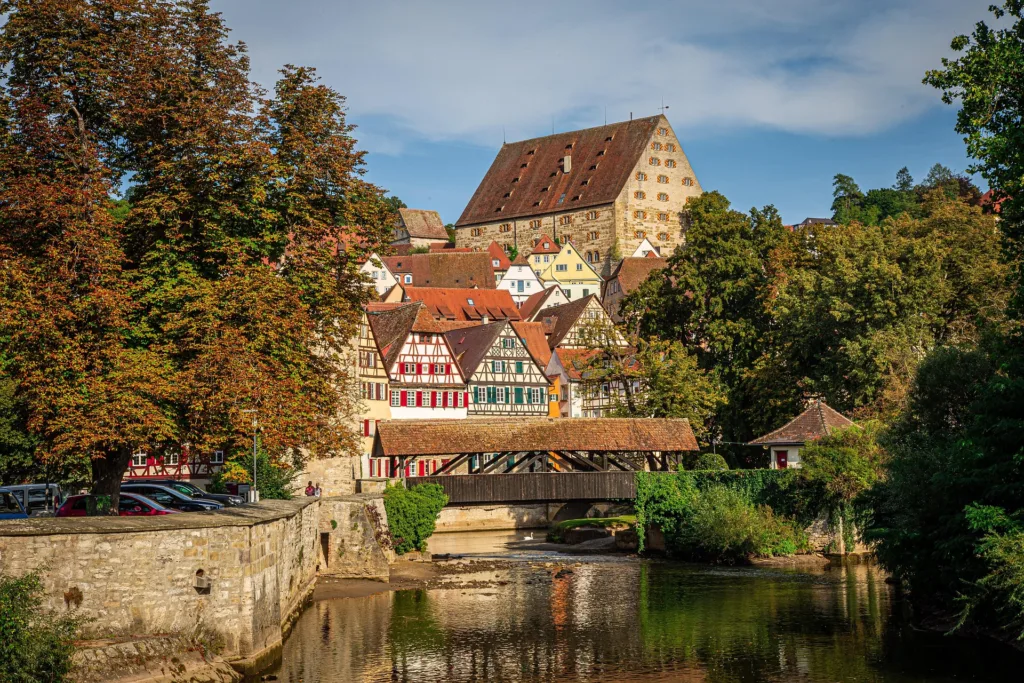
Image by Th G
Why Visit Schwäbisch Hall?
Schwäbisch Hall is a lesser-known but equally magical destination that overflows with medieval charm. With its winding cobblestone streets, colorful half-timbered houses, and picture-perfect riverside setting, this town looks like it was plucked from a storybook. Nestled along the Kocher River, Schwäbisch Hall combines historical beauty with a peaceful atmosphere, making it a dream destination for solo travelers seeking tranquility and inspiration.
The town also boasts a rich history as a salt-producing hub, which earned it wealth and architectural splendor during the Middle Ages. Today, visitors can wander its charming streets, admire beautifully preserved buildings, and soak in its unique blend of history and fairy-tale ambiance.
Highlights of Schwäbisch Hall
Salt Market Square
- Why Visit: At the heart of the Old Town lies the Marktplatz (Market Square), surrounded by colorful half-timbered houses and overlooked by the grand St. Michael’s Church. The square’s iconic staircase and vibrant atmosphere make it one of the most enchanting spots in Schwäbisch Hall.
- Fairy-Tale Moment:
“Standing at the top of St. Michael’s staircase and gazing over the lively Market Square feels like stepping into Cinderella’s world.” - Solo Travel Tips:
- Visit during the morning for peaceful exploration, or in the evening when the atmospheric lighting highlights the square’s fairy-tale charm.
- During summer, catch open-air theater performances on the steps of St. Michael’s Church.
Kocher River Bridges
- Why Visit: The Kocher River winds its way through the town, crossed by picturesque stone and wooden bridges. These enchanting bridges are framed by half-timbered houses that seem to float above the water.
- Fairy-Tale Moment:
“Walking the bridge while admiring the reflections of colorful houses in the river below feels like stepping into a dream.” - Solo Travel Tips:
- Bring your camera—this spot is perfect for postcard-worthy photos.
- Take a relaxing riverside stroll to appreciate the serene beauty of the town from different angles.
St. Michael’s Church
- Why Visit: Towering over the Marktplatz, this Gothic church is both a spiritual and architectural centerpiece of Schwäbisch Hall. Its intricate stonework and grand staircase make it a storybook setting.
- Fairy-Tale Moment:
“Climbing the staircase of St. Michael’s Church as the bells chime in the background feels like ascending into a fairy-tale kingdom.” - Solo Travel Tips:
- Climb to the tower for panoramic views of the Old Town and surrounding countryside.
- Sit on the staircase to enjoy a quiet coffee or reflect on your travels.
Schwäbisch Hall Old Town
- Why Visit: The town’s Old Town is a labyrinth of cobblestone streets lined with colorful shops, quaint cafés, and historic buildings. Every corner reveals a hidden courtyard or beautifully preserved facade brimming with character.
- Fairy-Tale Moment:
“Wandering the narrow streets of the Old Town, surrounded by half-timbered houses and flower-draped balconies, feels like being part of a fairy-tale adventure.” - Solo Travel Tips:
- Explore hidden alleys away from the main crowds—perfect for quiet moments and unique photography opportunities.
Solo Travel Tips for Schwäbisch Hall
Best Time to Visit
- Spring (April-May): The town’s flowers are in full bloom, and the weather is perfect for river walks.
- Summer (June-August): Enjoy the lively ambiance of open-air performances and festivals in the Market Square.
- Autumn (September-October): The warm tones of fall create magical photography opportunities.
- Winter (December): The town transforms into a holiday dreamscape with its quiet Christmas market and glowing lights.
How to Get There
- By Train: Schwäbisch Hall is accessible by train from Stuttgart (1 hour). The town’s compact size makes it easy to explore on foot straight from the station.
- By Car: Driving to Schwäbisch Hall is an enchanting option, allowing you to admire the surrounding countryside. Parking is available near the Old Town.
Where to Stay
- Hotel Kronprinz: A boutique hotel with historic charm, located just steps from the main square.
- Romantik Hotel Der Adelshof: A luxurious option offering stunning views of the Old Town and cozy, fairy-tale-inspired rooms.
Dining Recommendations
- Entenkeller Restaurant: A charming spot serving hearty Swabian dishes like Maultaschen (Swabian-style dumplings) and Kässpätzle (cheese noodles).
- Café Ableitner: A cozy café offering baked goods and coffee, ideal for a riverside break.
Why Schwäbisch Hall Should Be on Your Travel List
Schwäbisch Hall is the ultimate hidden gem for fairy-tale lovers. With its scenic riverside bridges, colorful Marktplatz, and medieval ambiance, it offers all the magic of better-known destinations without the crowds. Its quiet charm, paired with vibrant cultural life and irresistible beauty, makes it perfect for solo travelers seeking peace, inspiration, and the thrill of discovery.
Solo Travel Tips for Visiting Germany’s Fairy-Tale Towns
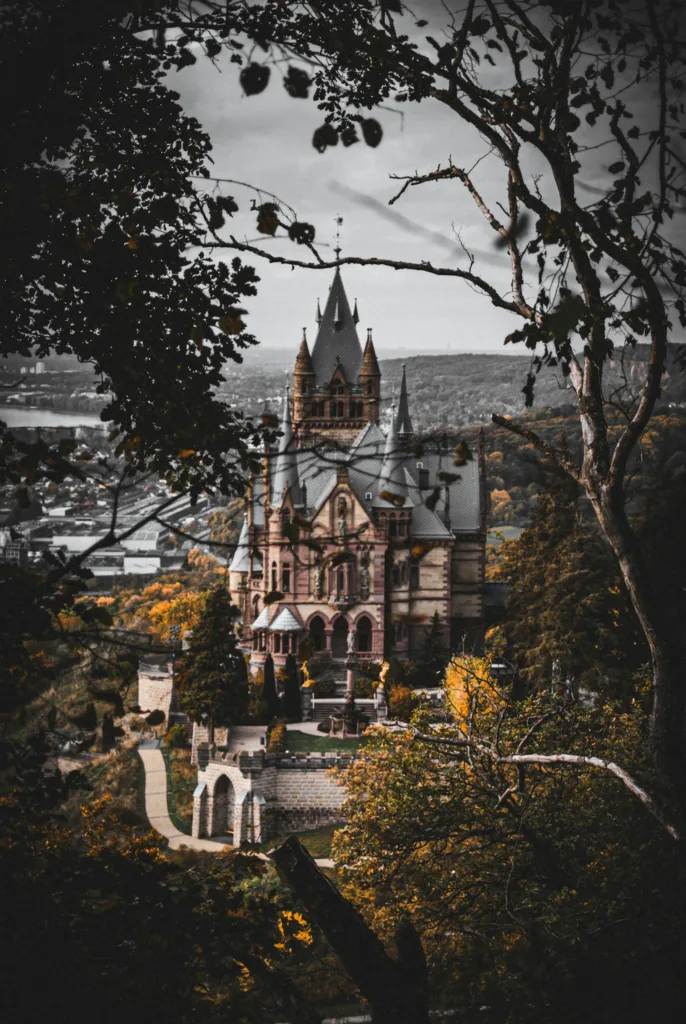
Photo by Juri Schick
Exploring Germany’s fairy-tale towns on your own is an adventure straight out of a storybook. These picturesque destinations are perfect for solo travelers, with peaceful cobblestone streets, stunning castles, and breathtaking landscapes. To make your journey smooth and magical, here’s a guide packed with tips tailored just for you and your visit to these 10 incredible towns.
1. Plan Your Route Like a Pro
These towns are scattered across Germany, so it’s important to map your trip in a way that saves you time and energy.
- Cluster Your Destinations:
- Combine Rothenburg, Füssen, and Schwäbisch Hall in one route since they’re all in southern Germany.
- Pair Bamberg and Cochem in the west, especially if you love castles and riverside scenery.
- Explore Wernigerode and Quedlinburg together in the central Harz Mountains area—these towns are just a short train ride apart.
- In the east, Görlitz makes for a great final stop, especially if you’re arriving from Dresden or Berlin.
- If you don’t have a car, use regional trains and buses. Germany’s Deutsche Bahn app is your best friend for figuring out schedules and smooth connections.
2. Start Early for a More Peaceful Experience
Fairy-tale towns are popular, especially during holidays or peak travel seasons. One of the best things you can do is get up early and start your day before the crowds arrive.
- Iconic Spots: Imagine taking a quiet photo of Plönlein corner in Rothenburg or strolling alone along the bridges of Cochem’s Moselle River. These picture-perfect moments are all yours in the early hours.
- Extra Tip Just for You: Morning light is not only great for photos, but it creates a special calm that lets you feel like the town belongs only to you.
3. Book Castles and Tours in Advance
Some of the most popular attractions, like Neuschwanstein Castle near Füssen, sell out fast. Booking online before your trip helps you avoid long lines or disappointment.
- Neuschwanstein Castle: Try to book the earliest time slot when it’s quieter, so you can enjoy the magical views from Marienbrücke without too many other visitors around.
- Reichsburg Castle in Cochem: Tours often include captivating stories about the castle’s history—it’s worth planning ahead to secure a spot.
- Solo Tip: Many towns offer free self-guided walking maps, which are perfect if you prefer to explore landmarks like castles and historic streets at your own pace.
4. Stay Overnight for the Real Magic
While day trips are convenient, staying overnight in these places unlocks an entirely different experience. Once the daytime crowds leave, the streets quiet down, and you’ll feel like you’ve stepped into another era.
- In Rothenburg, lanterns light up the cobblestones, and walking along the medieval walls feels like time travel.
- Monschau comes alive with a serene glow as the riverside reflects the twinkling lights from half-timbered houses.
- Quedlinburg at night is magical, especially if you take in the view from Castle Hill as the town’s rooftops glimmer below.
5. Pack Smart for Cobblestones and Castles
Fairy-tale towns are gorgeous, but they’re also full of uneven cobblestone streets and uphill paths (especially to castles). You’ll want to pack wisely:
- Shoes Matter: Comfortable walking shoes with good grip are non-negotiable. Think function over fashion here—your feet will thank you.
- Light Layers: The weather can change quickly, especially in places like the Harz Mountains or near the Alps in Füssen. A lightweight jacket or cardigan is perfect for layering.
6. Treat Yourself to Fairy-Tale Eats and Drinks
Part of the magic in these towns is sampling their local specialties. Don’t miss out:
- Snack on Schneeballen (snowball pastries) in Rothenburg—crispy and sugary, they’re everywhere in the Old Town.
- Sip smoky Rauchbier in Bamberg—a beer so unique it’s worth trying even if you’re not a beer drinker.
- Take it easy with a glass of Moselle Riesling in Cochem and let the views of the river and castle make it taste even better.
You’re traveling solo, so there’s no one to share food with—go ahead, order all the regional favorites for yourself!
7. Save Money With Regional Passes
Traveling solo doesn’t mean spending a fortune. Germany has amazing regional passes that make getting around affordable:
- The Bavaria Ticket: Gives you unlimited travel on trains, buses, and even trams for one day across Bavaria—including Rothenburg, Füssen, and Schwäbisch Hall.
- HarzCard: A smart choice if you’re exploring Wernigerode or Quedlinburg, with free entry to castles and discounts for steam train rides.
- Moselle Pass: Perfect for Cochem, giving you discounts on river cruises and wine tastings.
Use these passes and enjoy exploring multiple towns at a fraction of the cost!
8. Take Time to Wander Off the Main Paths
Fairy-tale towns have charming main squares and famous landmarks, but some of the best moments happen when you wander.
- In Quedlinburg, take a quiet stroll down Hölle Street, a hidden alleyway filled with half-timbered houses untouched by time.
- Görlitz has stunning courtyards and quiet corners in Untermarkt Square that most tourists miss.
- In Monschau, explore small bridges and sit by the river away from the crowds—it’s the perfect place to relax and reflect.
9. Photograph the Magic Thoughtfully
You’re in one of the most photographable regions in the world, but think beyond the usual shots:
- At Neuschwanstein, climb higher on trails around Marienbrücke for a unique perspective of the castle.
- Use the reflections from rivers like the Moselle in Cochem or the Kocher in Schwäbisch Hall to create dreamlike photos.
- Don’t forget to slow down and just enjoy the view—sometimes the best memory isn’t captured through a lens.
10. Let the Fairy Tale Unfold at Your Own Pace
Solo travel is your chance to experience these towns without anyone else’s agenda to worry about. Take your time sipping coffee at a quiet café, walk aimlessly through cobblestone streets, or sit by a castle and let the atmosphere sink in. You’re in your own story now, and these fairy-tale towns are your enchanted backdrop.
With these tips, you’ll not only explore Germany’s 10 fairy-tale towns in style but also enjoy the freedom, reflection, and magic that solo travel brings. Whether you’re marveling at castles, wandering historic streets, or sipping wine by the river, this journey is all yours to create.
FAQs About Visiting Germany’s Magical Fairy-Tale Towns
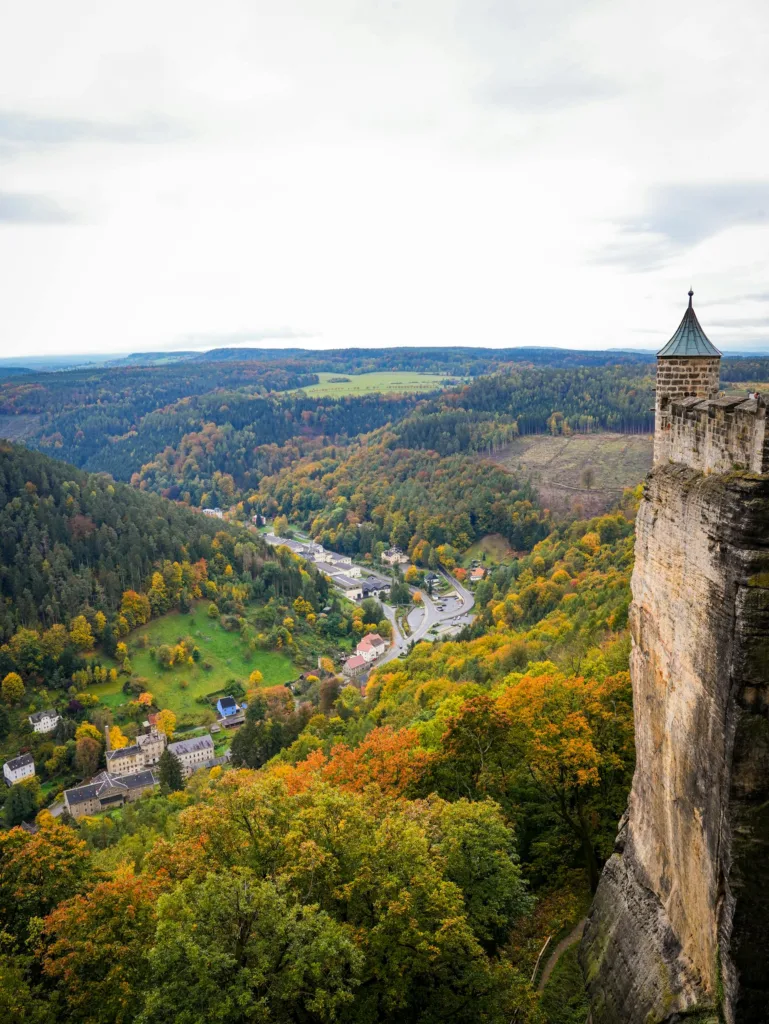
Photo by Kiran
1. What are the most beautiful medieval towns to visit in Germany?
Germany is home to countless medieval towns where cobblestone streets, half-timbered houses, and castles transport you back in time. Some of the most beautiful include:
- Rothenburg ob der Tauber: A perfectly preserved walled city, famous for its fairy-tale charm and Plönlein corner.
- Quedlinburg: A UNESCO World Heritage Site with over 1,200 half-timbered houses.
- Bamberg: Known as “Little Venice,” this scenic town is a masterpiece of canals, bridges, and medieval heritage.
- Monschau: Nestled in the Rur Valley, this peaceful riverside gem is surrounded by rolling hills.
- Füssen: The gateway to Neuschwanstein Castle, Füssen offers a combination of Alpine beauty and historic appeal.
Each town looks like it’s been plucked straight from a storybook!
2. What is the German Fairy Tale Route, and which towns are part of it?
The German Fairy Tale Route (Deutsche Märchenstraße) is a 370-mile journey that connects destinations tied to the Brothers Grimm and their famous stories. This route spans from Hanau (their birthplace) to Bremen, weaving through picturesque towns, castles, and forests. Key towns include:
- Marburg: Where the Brothers Grimm studied and drew inspiration.
- Hanau: Home to museums and statues celebrating their legacy.
- Hameln: The setting for The Pied Piper.
- Kassel: Features Grimmwelt Museum dedicated to their work.
- Sababurg: Known as Sleeping Beauty’s castle.
The route is ideal for travelers looking to combine whimsical stories with historically rich towns.
3. Is Rothenburg ob der Tauber worth visiting?
Yes, Rothenburg ob der Tauber is easily one of the most enchanting towns to visit in Germany. Famous for its medieval walls, half-timbered architecture, and romantic charm, it’s like stepping into the pages of a storybook. Highlights include:
- Plönlein Corner: The most photographed spot in Rothenburg.
- Medieval City Walls: Walk the walls for panoramic views of the Old Town.
- Night Watchman Tour: A fun, storytelling-driven tour of the town’s medieval history.
- Christmas Village (year-round): Visit Käthe Wohlfahrt’s Christmas shop for holiday magic any time of year.
Rothenburg is a must-see for solo travelers, photographers, and history lovers alike.
4. How do I get from Munich to Neuschwanstein Castle?
Getting to Neuschwanstein Castle from Munich is straightforward:
- By Train: Take a train from Munich to Füssen (approx. 2 hours). From there, local buses (e.g., Bus 73 or 78) connect directly to Hohenschwangau village, where the castle is located.
- By Car: Drive from Munich to Hohenschwangau (approx. 1.5 hours) via the A7 highway. Parking is available near the ticket center.
- Organized Tours: Many day trips from Munich include round-trip transport and guided tours.
Extra Tip: Book your castle tickets online in advance to save time and secure a spot, especially during peak seasons. If you’re visiting solo, take time to enjoy nearby sights like Alpsee Lake and Hohenschwangau Castle.
5. Are Germany’s small towns safe for solo travelers?
Absolutely! Germany’s small towns are known for their safety, hospitality, and well-maintained infrastructure, making them ideal for solo travelers. Here’s why:
- Well-Lit Streets: Even in smaller towns, main areas and alleys are well-lit at night.
- Public Transport: Towns like Rothenburg, Bamberg, and Quedlinburg are well connected by train or bus, making it easy to navigate without worry.
- Friendly Locals: Many small-town Germans are welcoming, and locals are happy to give directions or recommendations.
- Solo Travel Tip: Stick to central accommodations near Old Towns for easy navigation. Rothenburg, Monschau, and Füssen are particularly great for relaxed, reflective solo adventures.
6. Can I visit Quedlinburg and Wernigerode in one day?
Yes, it’s possible to visit Quedlinburg and Wernigerode in a single day if you’re prepared for a busy schedule, but spending more time in each town is ideal to fully enjoy their charm.
- Distance: These two fairy-tale towns are only 30 minutes apart by train or car, making them easy to combine.
- Suggested Itinerary for a Day:
- Morning in Quedlinburg: Start early and explore the Old Town with its 1,200+ half-timbered houses and Castle Hill (Schlossberg) for panoramic views. Don’t miss St. Servatius Church or grabbing a pastry at a cozy café.
- Afternoon in Wernigerode: After lunch, head to Wernigerode and visit the colorful Old Town Square and the iconic Wernigerode Castle. If time permits, stroll through the Schlosspark or enjoy a Harz steam-train ride.
- Tips for a Smooth Visit:
- Use the Harz Narrow Gauge Railway (Harzer Schmalspurbahn)for a scenic and nostalgic train ride between the two towns if traveling by public transport.
- If you’re short on time, focus on exploring just one key attraction in each town—Castle Hill in Quedlinburg and Wernigerode Castle are top picks.
While one day works, staying overnight lets you immerse yourself in the ambiance of both towns without rushing.
7. What are some must-see castles in Germany’s fairy-tale towns?
Germany’s fairy-tale towns are filled with spectacular castles that bring centuries of history to life. Here are the unmissable ones in your fairy-tale itinerary:
- Neuschwanstein Castle (Füssen): The ultimate fairy-tale castle, known as the inspiration for Disney’s Sleeping Beauty Castle. Its stunning alpine location makes it a global icon.
- Reichsburg Castle (Cochem): A hilltop fortress overlooking the Moselle River with a romantic Gothic design and incredible vineyard views.
- Wernigerode Castle: Perched above Wernigerode, this castle combines medieval charm with dramatic views of the Harz Mountains.
- Schloss Quedlinburg: Located on Castle Hill, this historic castle offers a quiet sense of grandeur and insights into Germany’s early medieval history.
- Hohes Schloss (Füssen): Often overshadowed by Neuschwanstein, this castle in the Old Town of Füssen features fascinating frescoes and a peaceful, picturesque setting.
Pro Tip: For photographers, plan your visits during golden hour or visit nearby viewpoints to capture majestic castle landscapes.
8. Which medieval towns are easiest to explore without a car?
Germany’s medieval towns are well-connected by train and buses, so you don’t necessarily need a car to explore them. Some fairy-tale towns are especially convenient for car-free travel:
- Rothenburg ob der Tauber: Part of the Romantic Road, this town is easily accessible by train from cities like Würzburg or Nuremberg. The compact Old Town is perfect for walking.
- Quedlinburg: A UNESCO World Heritage Site, Quedlinburg has direct train connections to Magdeburg and Halle, and its attractions are all within walking distance.
- Wernigerode: Frequent trains link Wernigerode to the Harz Mountains region, and buses also make it easy to explore nearby attractions.
- Bamberg: Bamberg’s train station connects to major hubs like Nuremberg and Munich, and its Old Town is walkable, from the Altes Rathaus to the canals of Little Venice.
- Görlitz: This picturesque town on the Polish border is accessible by train from Dresden or Berlin, with most sights concentrated in its Old Town.
Travel Tip: Use regional passes like the Bayern Ticket or HarzCard to save on transportation.
9. Can I do a day trip to Görlitz from Berlin or Dresden?
Yes, Görlitz is an excellent day trip destination from both Berlin and Dresden. Its cinematic charm and well-preserved architecture make it worth the journey.
- From Berlin:
- Travel Time: Approx. 2.5 hours one-way by train.
- How to Get There: Take a direct regional train (EC or RB) to Görlitz. The route offers scenic views of the German countryside.
- From Dresden:
- Travel Time: About 1 hour 15 minutes one-way by train.
- How to Get There: Regional trains run frequently between Dresden and Görlitz, making it ideal for a shorter trip.
- What to Do in a Day:
- Stroll through Untermarkt and Obermarkt, photographing its pastel-colored facades and striking town squares.
- Visit St. Peter and Paul’s Church and cross the Old Town Bridge for beautiful views of the Neiße River.
- End your trip with coffee at a quaint café or explore the town’s Art Nouveau gems.
Pro Tip: Görlitz is quieter and less touristy than other towns, making it an excellent solo escape for the day.
10. How long should I stay in Bamberg to fully explore it?
To fully experience Bamberg’s picturesque beauty and historic charm, 1-2 days is the ideal amount of time to stay.
- One Day Itinerary:
- Morning: Visit the UNESCO-listed Old Town and snap iconic photos of the Altes Rathaus (Old Town Hall) perched over the river.
- Afternoon: Stroll through Little Venice and explore the vibrant canals.
- Evening: Relax with a smoked beer (Rauchbier) at Schlenkerla Brewery for an authentic Franconian experience.
- Two-Day Itinerary:
- Day 1: Explore the Old Town, visit Bamberg Cathedral, and watch the sunset at the Rose Garden.
- Day 2: Take a relaxing boat tour through Little Venice or explore nearby hiking paths.
Pro Tip: Staying overnight means you can enjoy Bamberg’s quieter side after day-trippers leave and fully savor its cozy cafes and evening lights.
11. What’s the most scenic way to explore the Moselle Valley?
The Moselle Valley is one of Germany’s most beautiful regions, known for its picturesque vineyards, meandering river, and fairy-tale castles like Reichsburg Castle in Cochem. Here’s how you can explore it:
- By River Cruise:
- A cruise along the Moselle River offers stunning views of terraced vineyards and charming towns like Bernkastel-Kues, Traben-Trarbach, and Cochem.
- Book a day cruise or shorter tours that allow you to relax while soaking in the scenery, especially during fall when the vineyards glow golden.
- By Car:
- Drive the winding scenic routes along the river banks, stopping at small wineries, lookout points, and castles like Eltz Castle, which is just a short detour from Cochem.
- Don’t miss Zell, a quaint village famous for the iconic Zeller Schwarze Katz wine.
- By Bicycle:
- The Moselle Cycle Route (Moselradweg) offers a flat, easy-to-follow bike path that passes through vineyards, riverside villages, and endless photo opportunities. Rentals are available locally.
- By Walking:
- Enjoy one of the region’s many hiking trails, such as the Calmont Klettersteig, which takes you through Europe’s steepest vineyards with jaw-dropping views of the river below.
Pro Tip: Pair your scenic exploration with a wine tasting! Many family-run wineries along the route offer intimate tastings of Riesling, the region’s signature wine.
12. What should I pack for a trip to Germany’s historic towns?
Traveling to Germany’s medieval towns requires packing smart to handle cobblestones, varied weather, and lots of walking. Here’s what you’ll need:
- Essential Clothing:
- Comfortable shoes: Opt for sturdy sneakers or walking shoes with good grip for cobblestone streets and uneven paths to castles.
- Weather-appropriate layers: Germany can be unpredictable, so pack for all conditions. Lightweight jackets, scarves, or a fleece layer are ideal.
- Packable raincoat or umbrella: Compact enough to keep with you, especially during spring and fall.
- In winter, add thermal layers, gloves, and a hat to stay cozy at Christmas markets.
- Travel Gear:
- A lightweight backpack for day trips—perfect for carrying water, snacks, and your guidebook.
- Power bank: Avoid running out of battery while photographing castles.
- Reusable water bottle: Tap water in Germany is safe, and fountains in towns can refill your bottle.
- Extras for Fairy-Tale Towns:
- Camera or smartphone tripod: For breathtaking photos of castles, cobblestone alleys, or riverside scenes.
- If cycling or walking part of the Moselle Valley, consider comfortable activewear and sunscreen.
Pro Tip: If visiting castles like Neuschwanstein, bring cash for kiosks and local eateries—some remote spots may not accept cards.
13. Is it better to visit Germany’s fairy-tale towns in summer or winter?
Both seasons have unique appeal, and the choice depends on what kind of fairy-tale vibe you’re looking for:
- Summer:
- Towns like Rothenburg, Cochem, and Bamberg are bustling with life, making it a great season for festivals, outdoor dining, and vibrant atmospheres.
- The surrounding landscapes of the Harz Mountains or Moselle Valley are lush and green, providing stunning backdrops for photography or hiking.
- Tip for Summer: Visit early mornings to avoid peak crowds and enjoy quieter explorations.
- Winter:
- Feel the magic of Christmas markets in towns like Rothenburg, Monschau, and Bamberg, all illuminated with festive lights.
- Snow adds to the fairy-tale vibe, especially in Alpine towns like Füssen near Neuschwanstein Castle, or Wernigerode with its magical winter ambiance.
- Tip for Winter: Dress warmly and stay overnight—it’s the best way to enjoy the peaceful, lit-up streets after the crowds leave.
Verdict: Choose summer for exploration and outdoor adventures. If you’re after enchanting coziness and Christmas magic, winter is unmatched. For something in between, spring (April-May) and autumn (September-October) can offer fewer crowds and perfect weather.
14. What’s the best way to spend an evening in a town like Monschau?
Evenings in Monschau are magical, offering a peaceful retreat after a day of sightseeing. Here’s how you can make the most of it:
- Take a Sunset Stroll:
- Walk along the Rur River as the half-timbered houses reflect in the water. Cross the stone bridges for different angles of Monschau, and climb to the castle ruins to watch the sunset over the valley.
- Dine in a Cozy Restaurant:
- Treat yourself to a traditional German dinner at Zur Höfener Hütteor Restaurant Rur-Café and enjoy local specialties like Sauerbraten (marinated roast).
- Enjoy a Warm Drink:
- Unwind with a hot cup of mulled wine or a local beer at a riverside cafe. Many spots along the Old Town stay cozy and inviting even as the night sets in.
- Photograph the Town Lights:
- After dark, the lantern-lined streets and soft glow from the windows make Monschau feel like a painting. Take quiet photos of the illuminated Old Town without the daytime crowds.
Monschau’s serene evenings are the perfect time to slow down and savor its fairy-tale charm.
15. Are there any special festivals in Germany’s small towns, like Rothenburg or Marburg?
Yes, Germany’s small towns host incredible festivals, many rooted in history and folklore. Here’s a taste of what you can experience:
- Rothenburg ob der Tauber:
- The Imperial City Festival (Reichsstadtfesttage) in September features medieval reenactments, concerts, and markets that transform the town into a living history exhibit.
- The Christmas Market (Reiterlesmarkt) in winter is one of Germany’s most magical holiday markets.
- Marburg:
- As part of the German Fairy Tale Route, Marburg celebrates Grimm-themed events in summer, including storytelling festivals and guided fairy-tale tours.
- Cochem:
- The Moselle Wine Festival, held in late summer, is perfect for sampling local wine while enjoying concerts and parades through the medieval streets.
- Bamberg:
- The Sandkerwa Festival (August): This folk festival features cultural performances, food stalls, and even events by the canals of Little Venice.
- Wernigerode:
- Don’t miss the Walpurgis Night festival (April 30th), where locals celebrate the folklore of witches in the Harz Mountains with bonfires and costumes.
Pro Tip: Plan your visit around these festivals for a deeper taste of local customs and livelier experiences in these fairy-tale towns.











